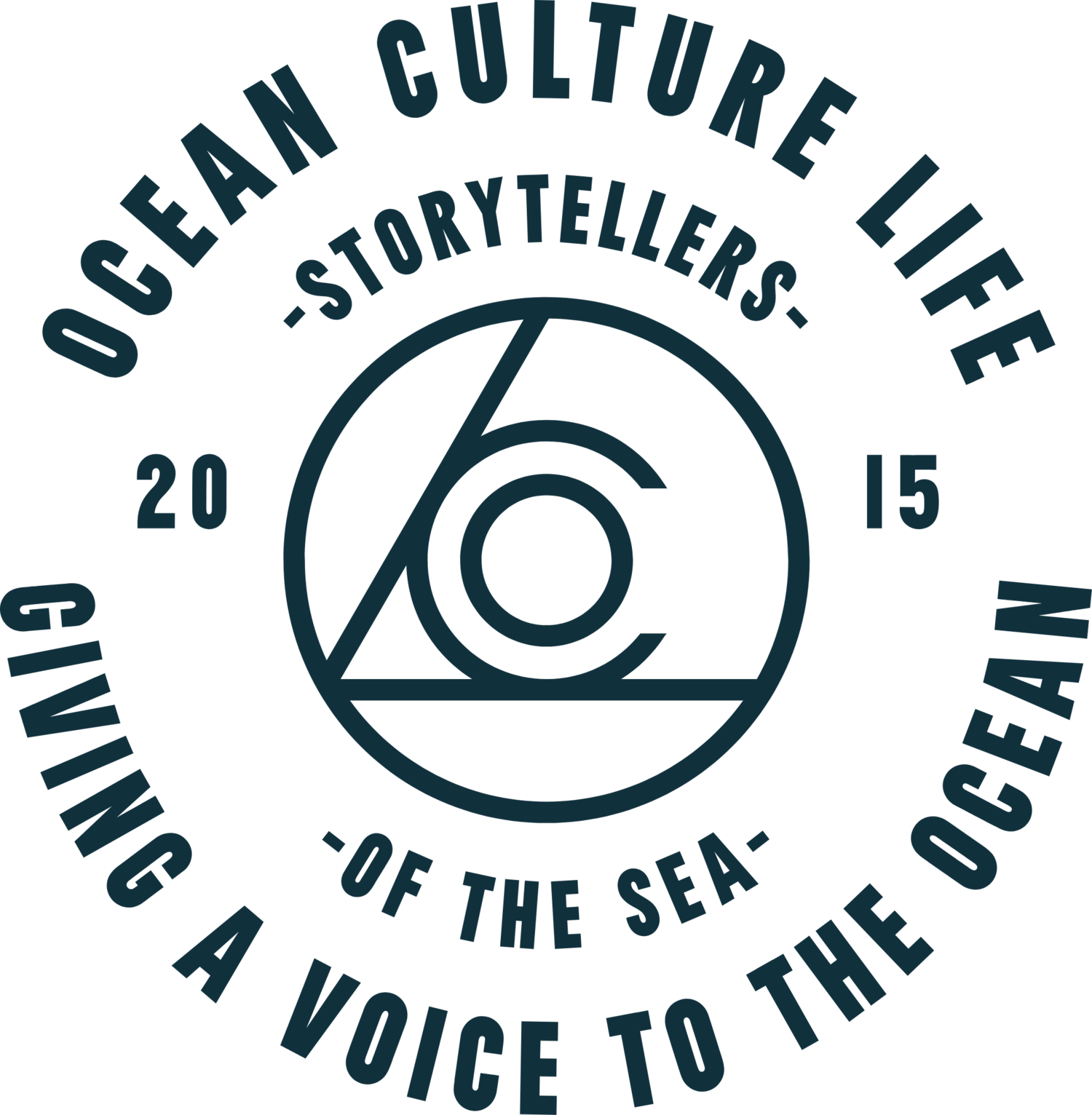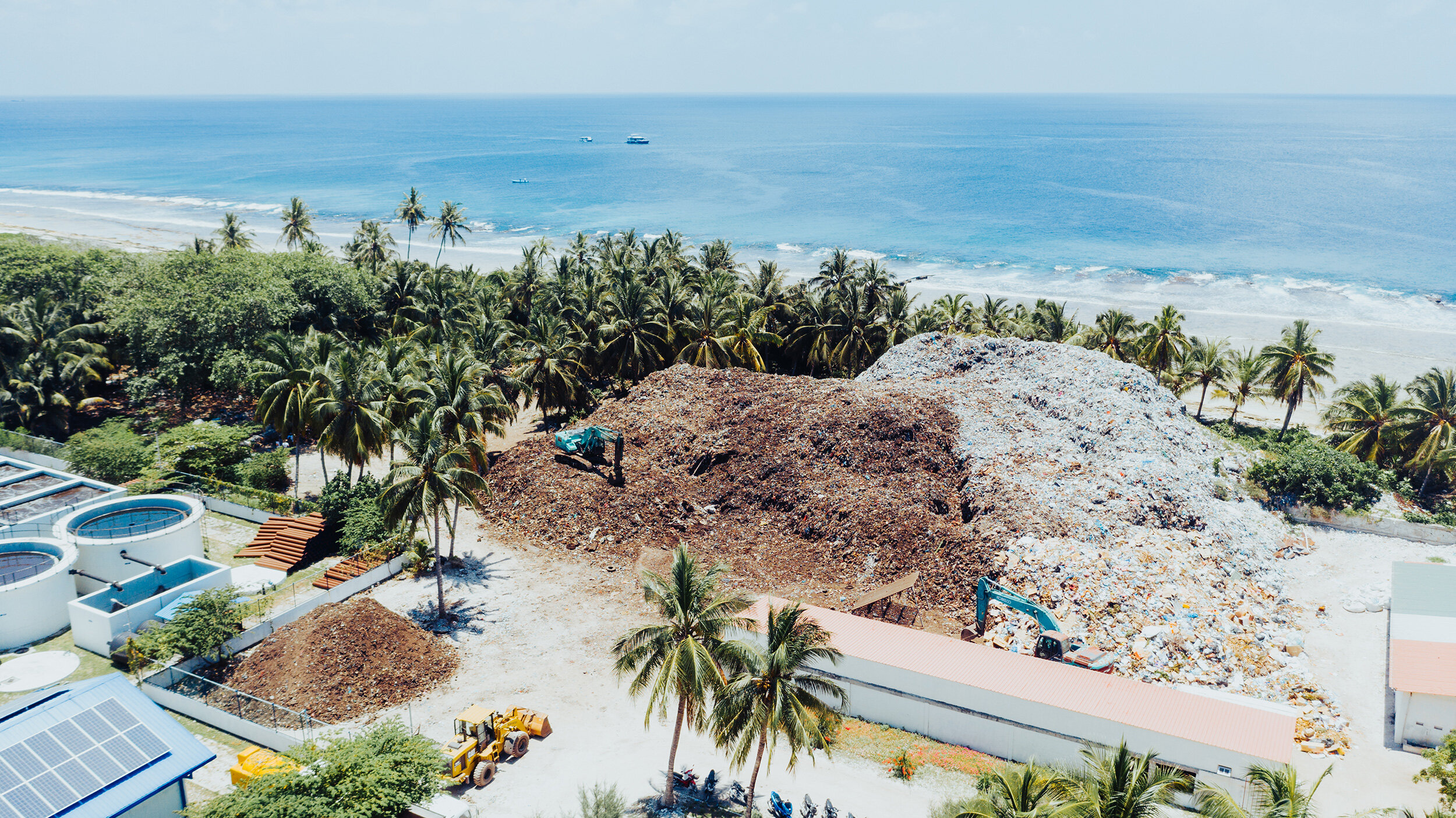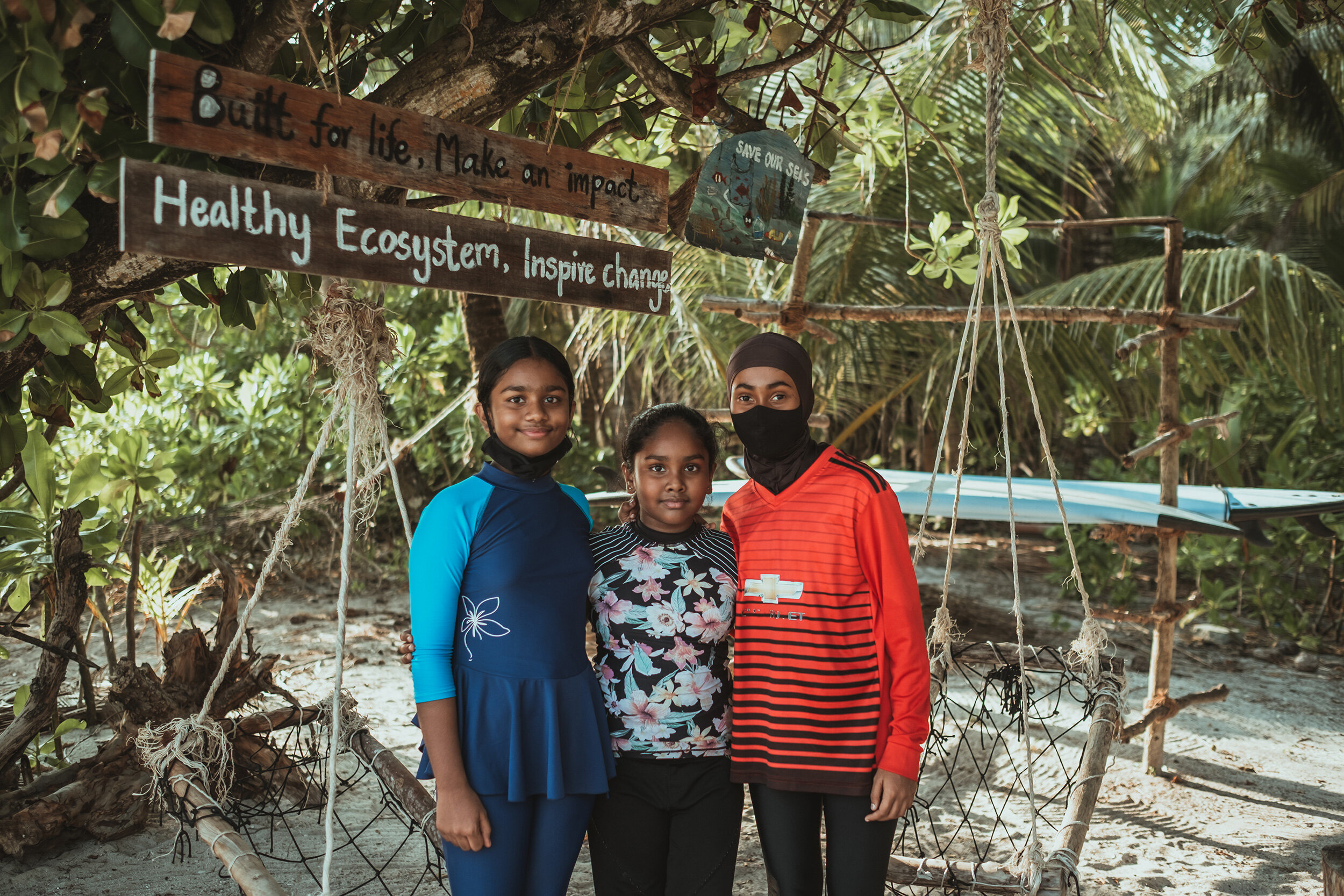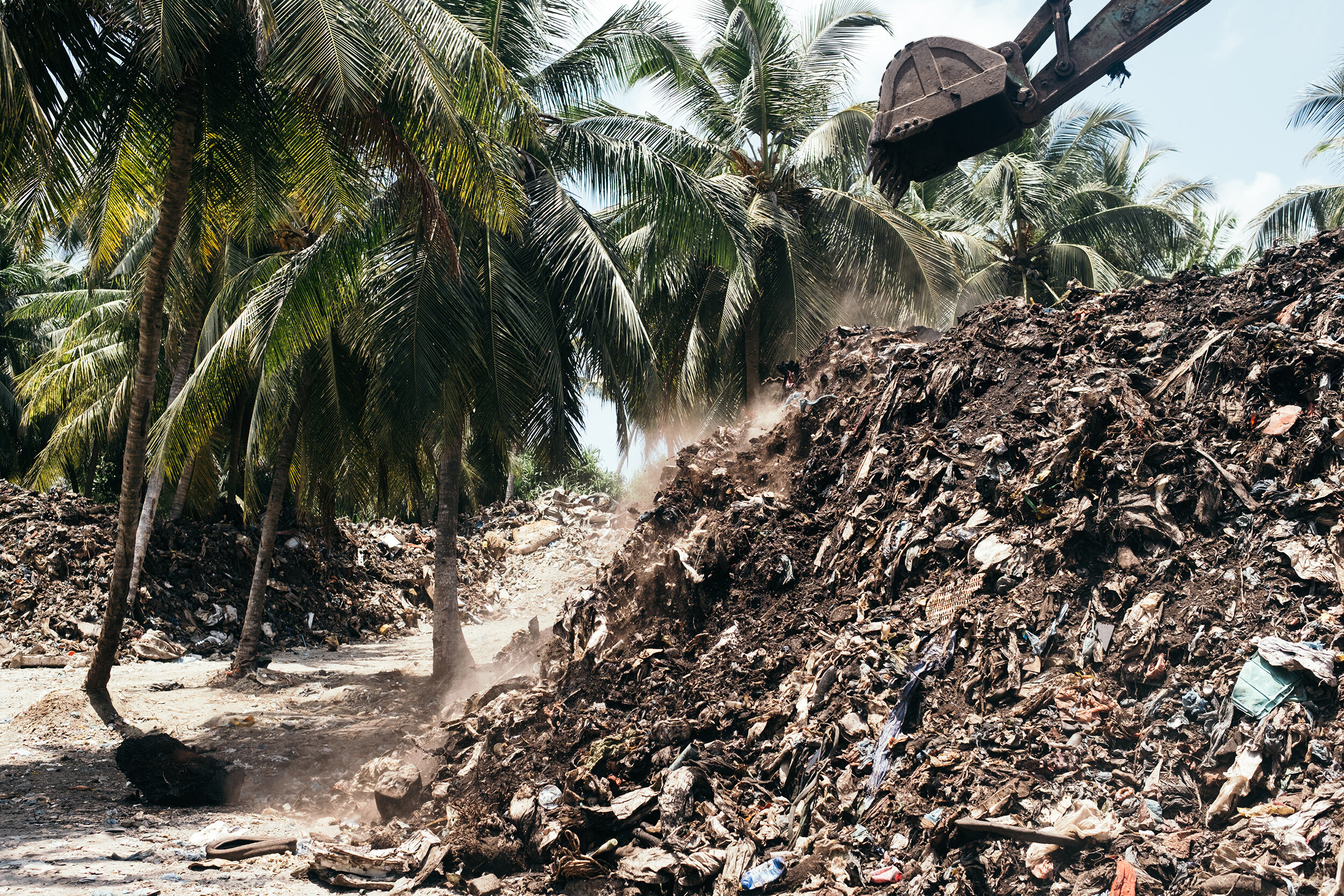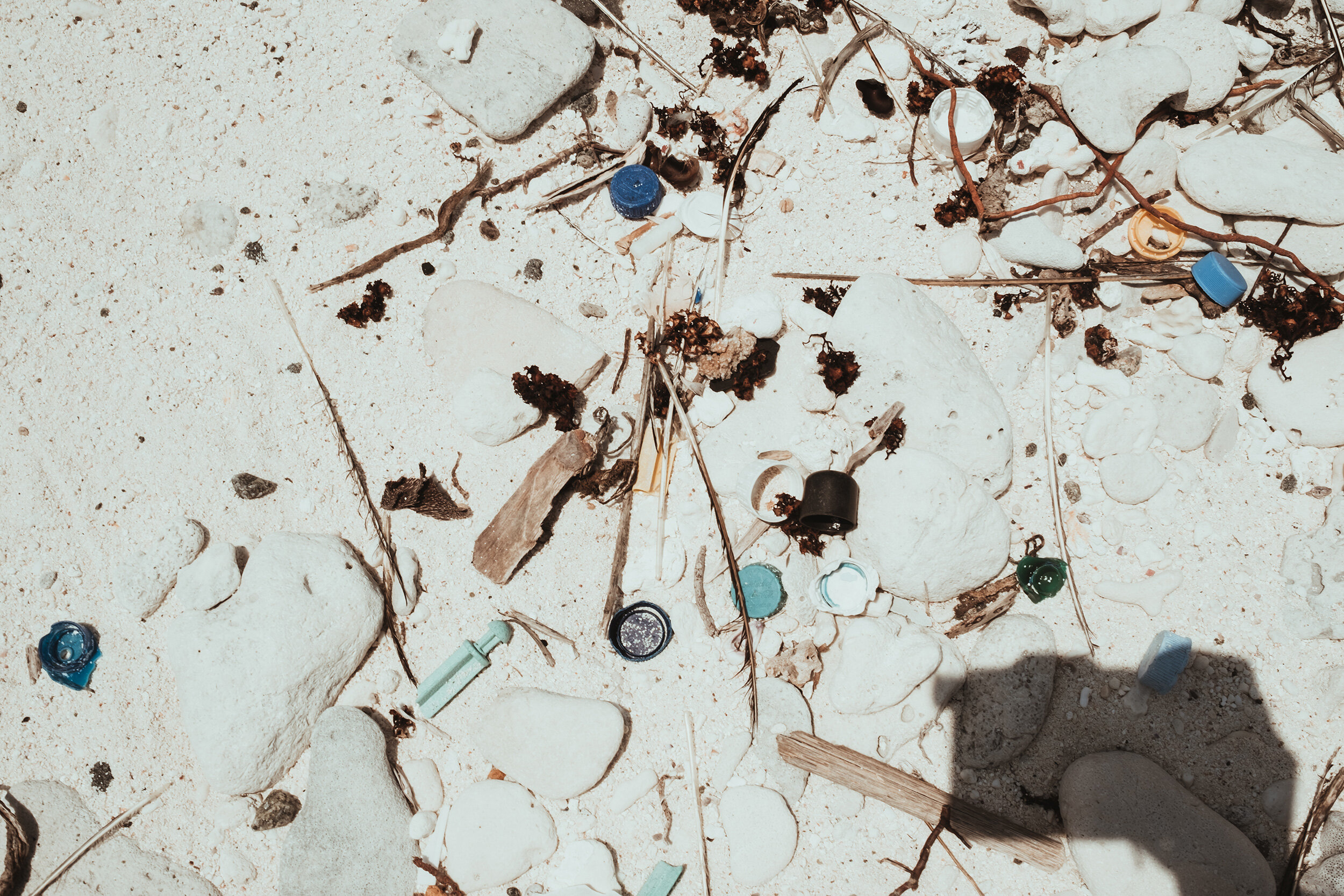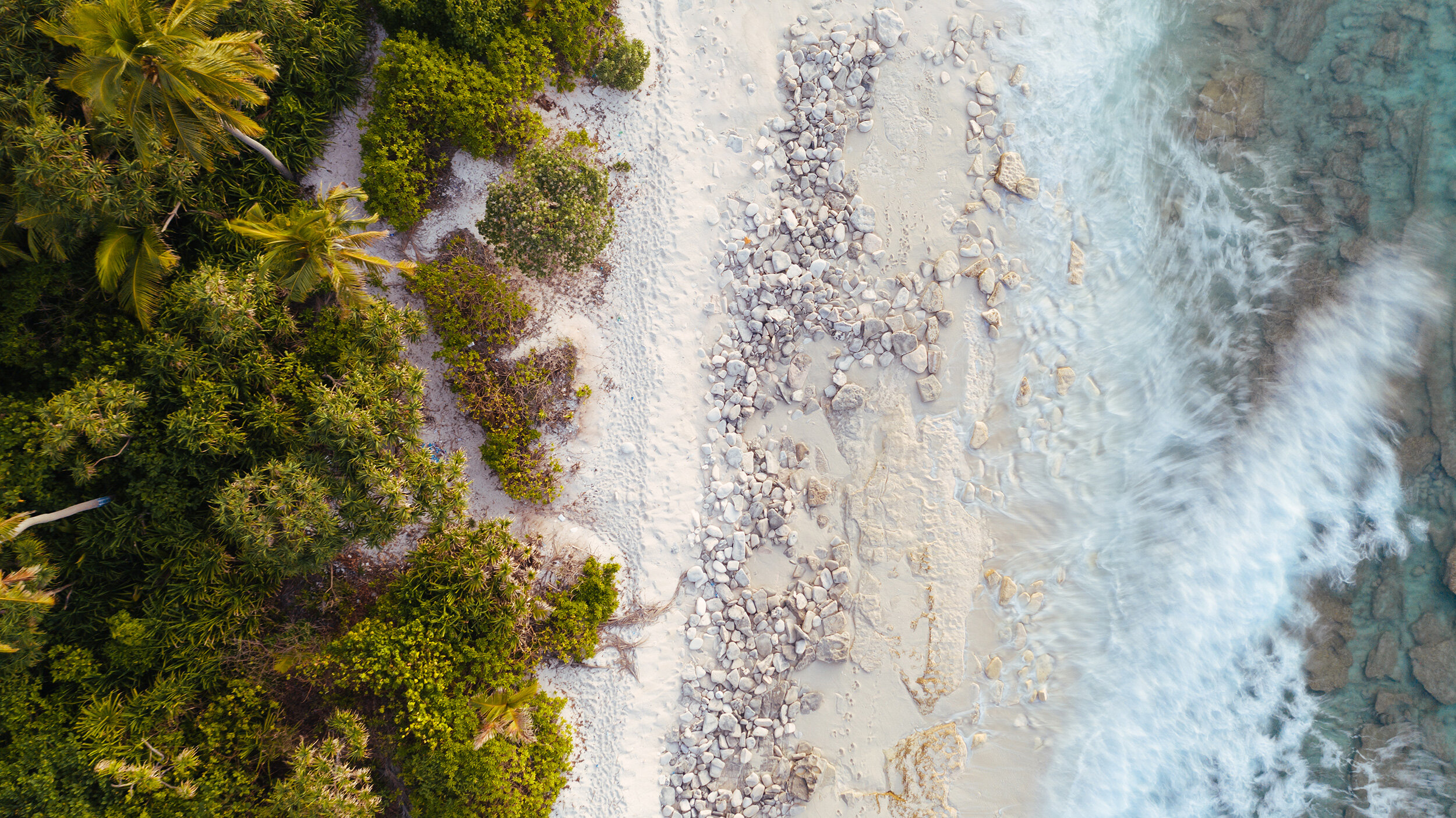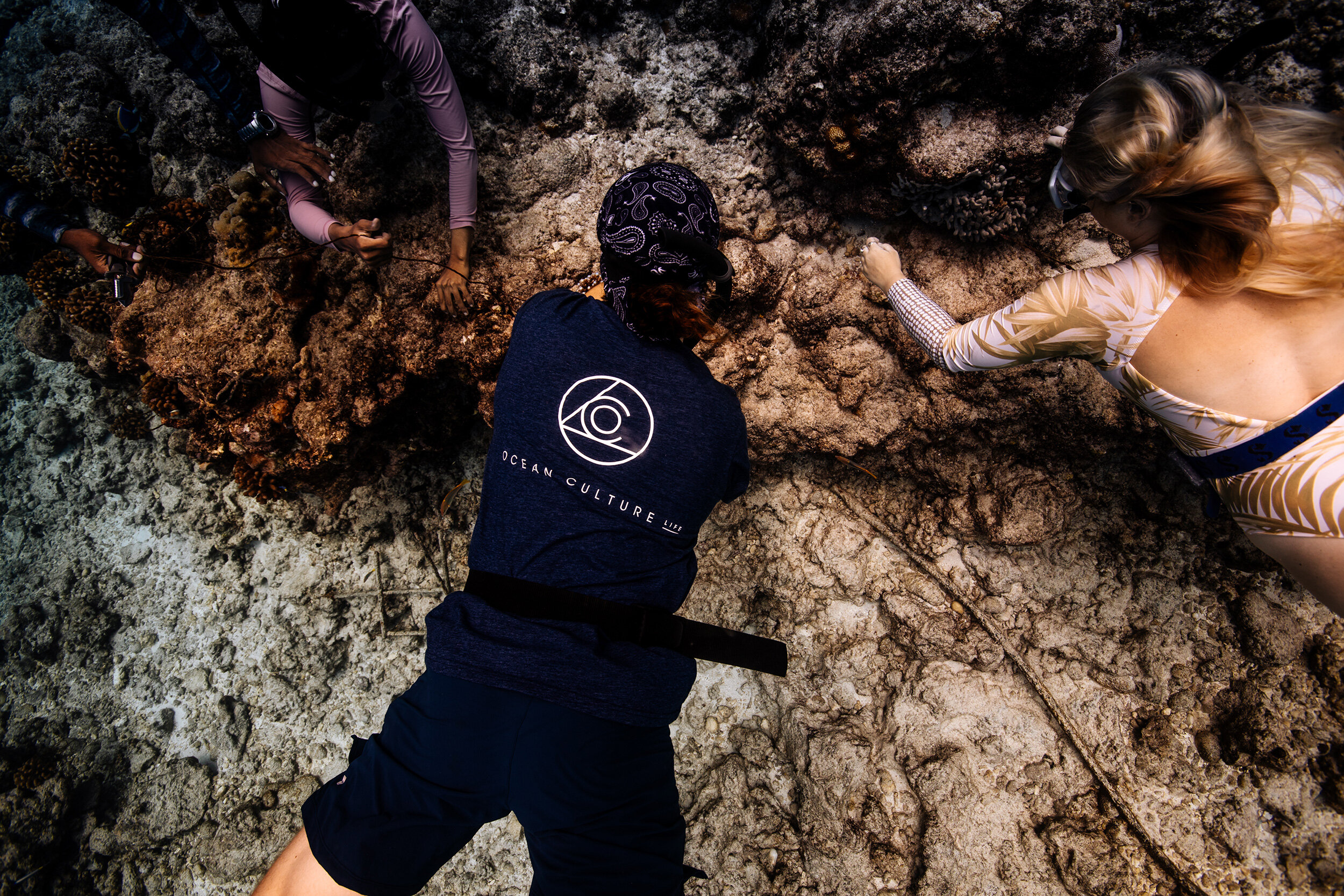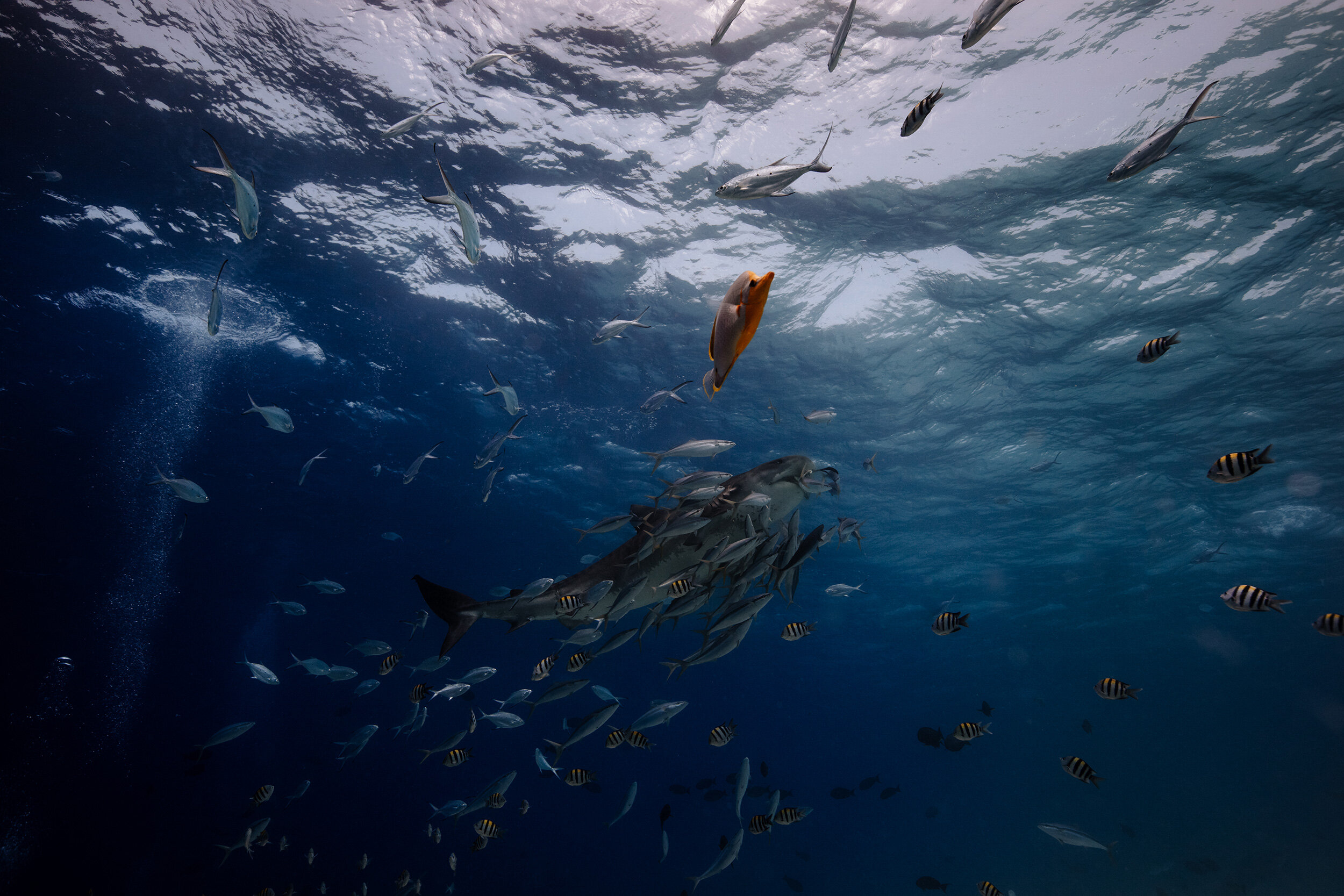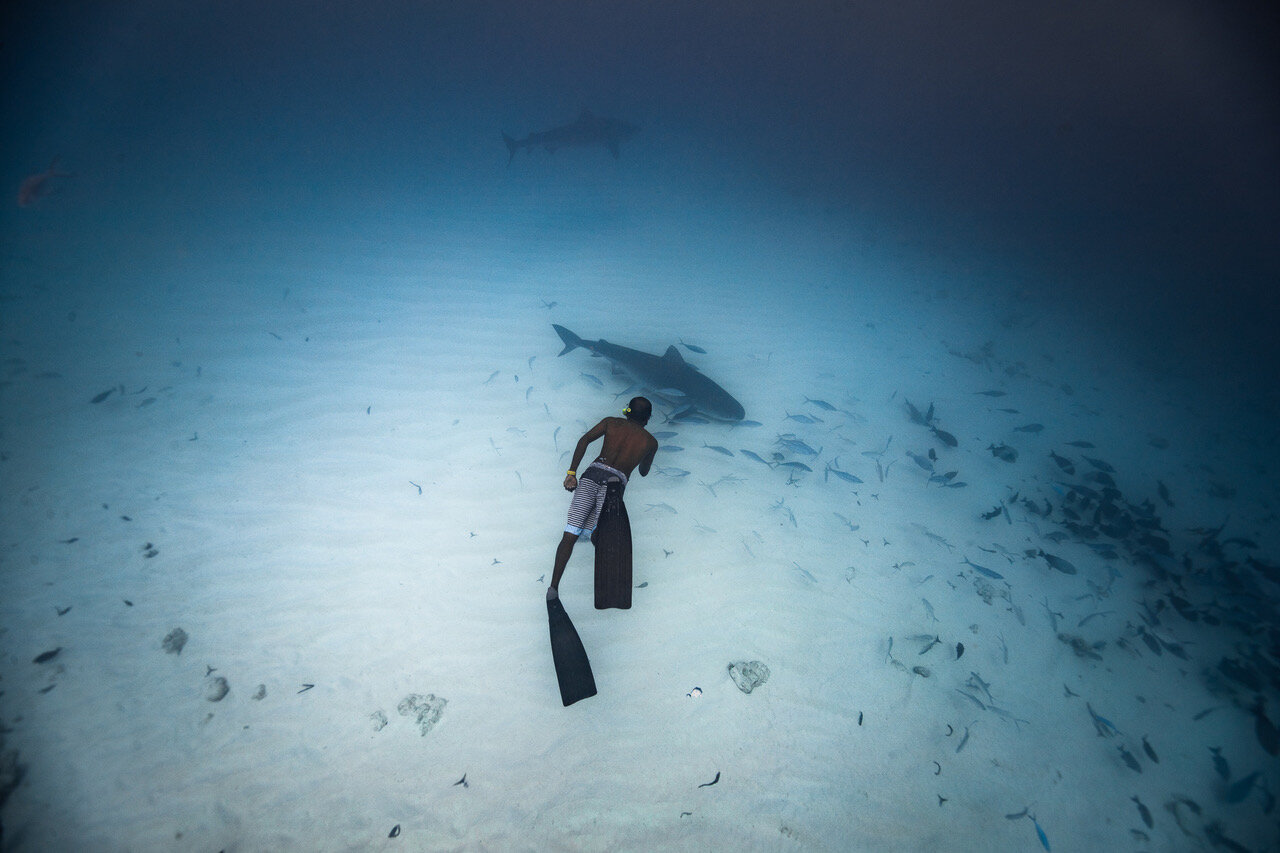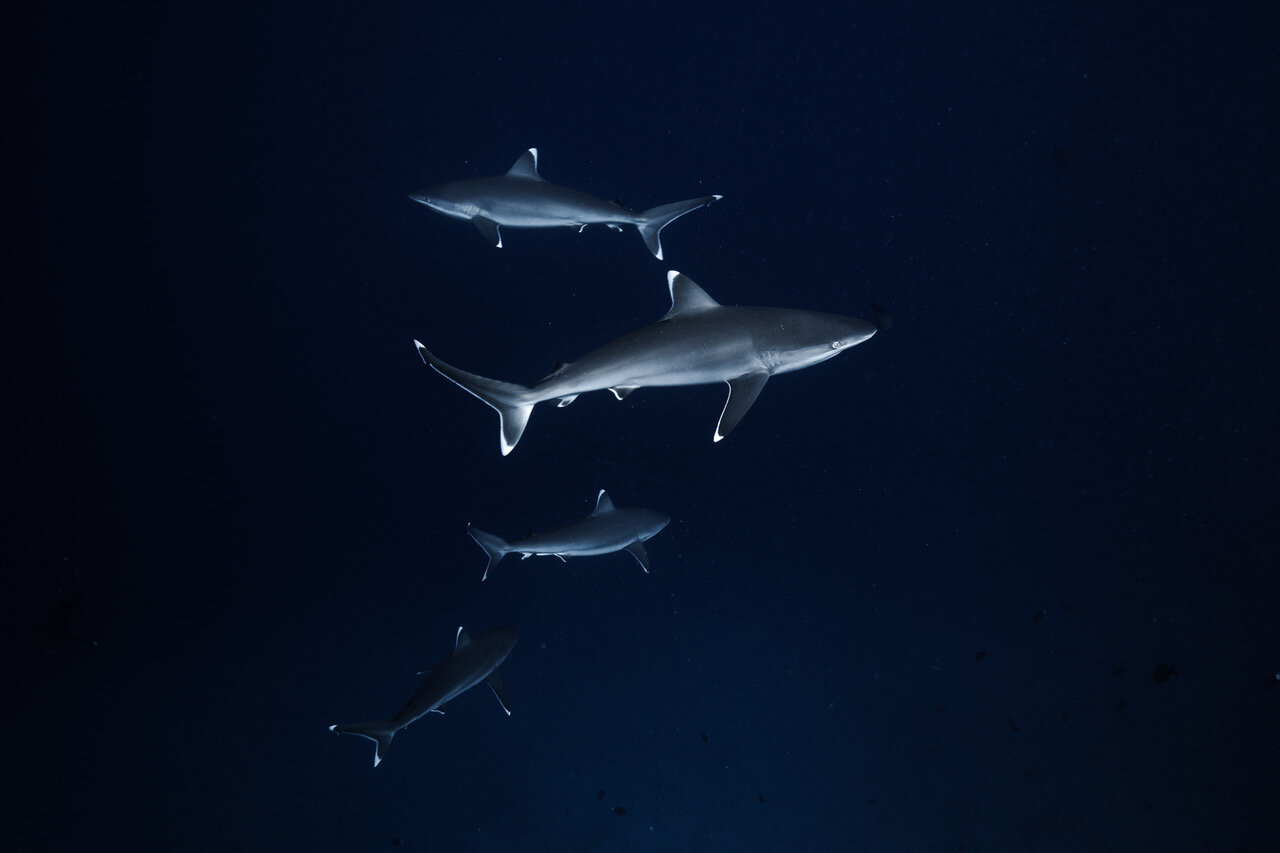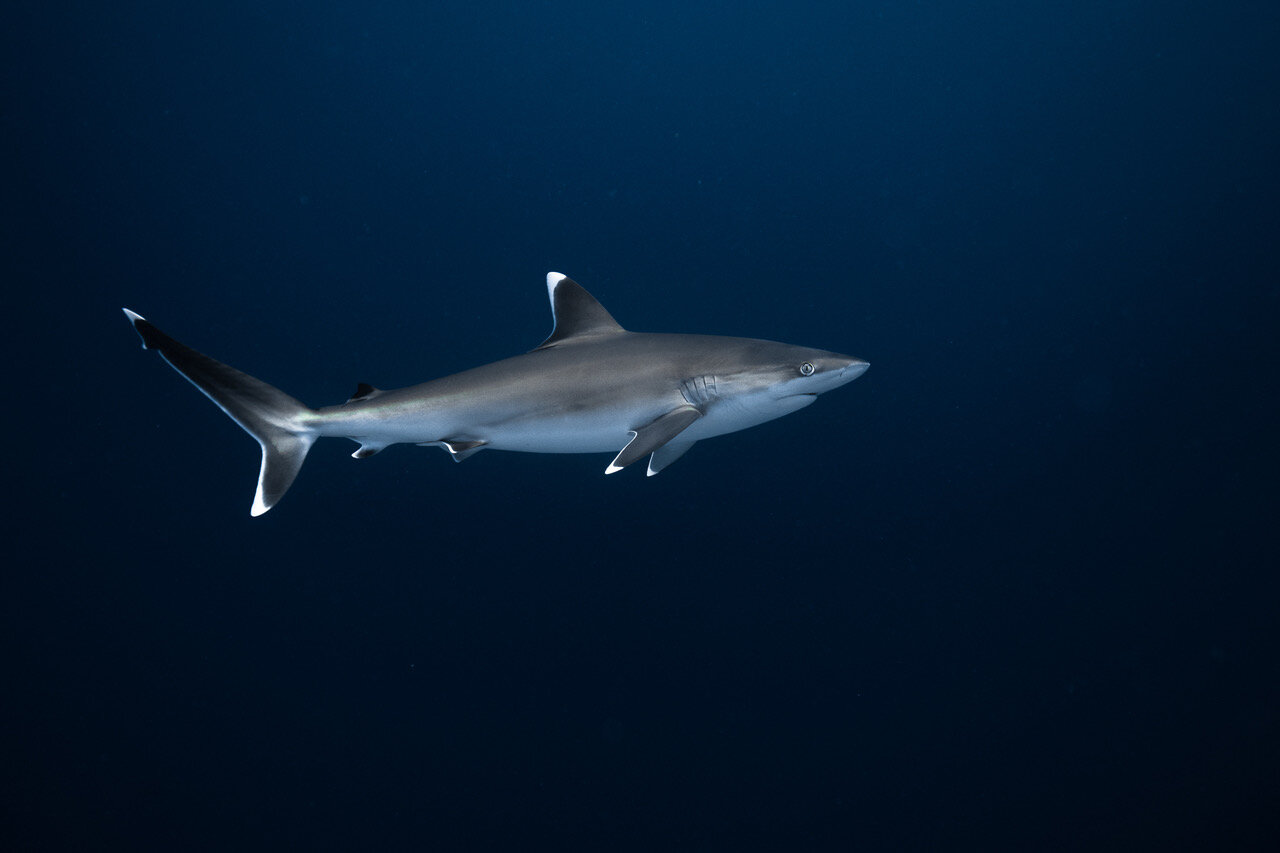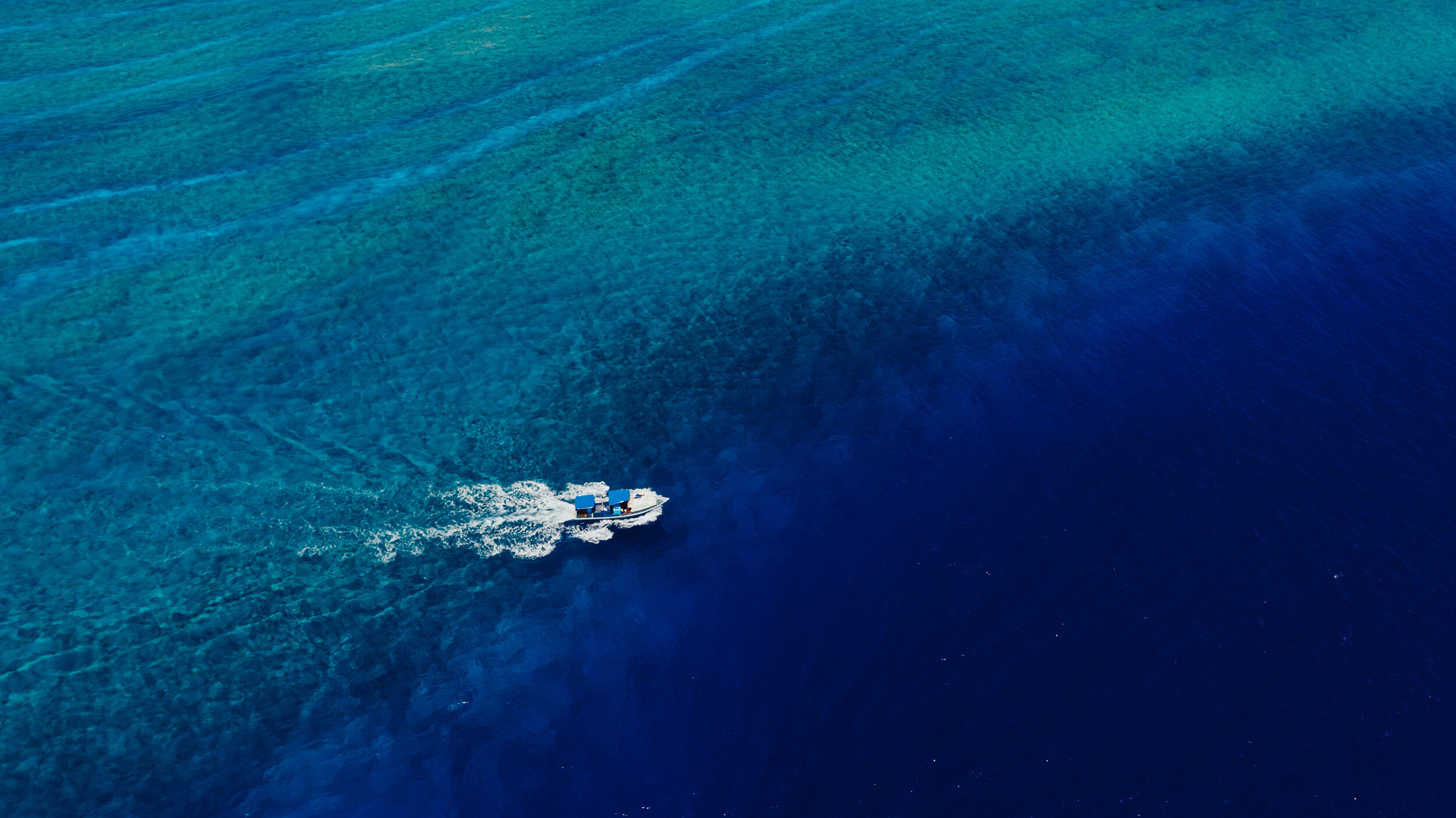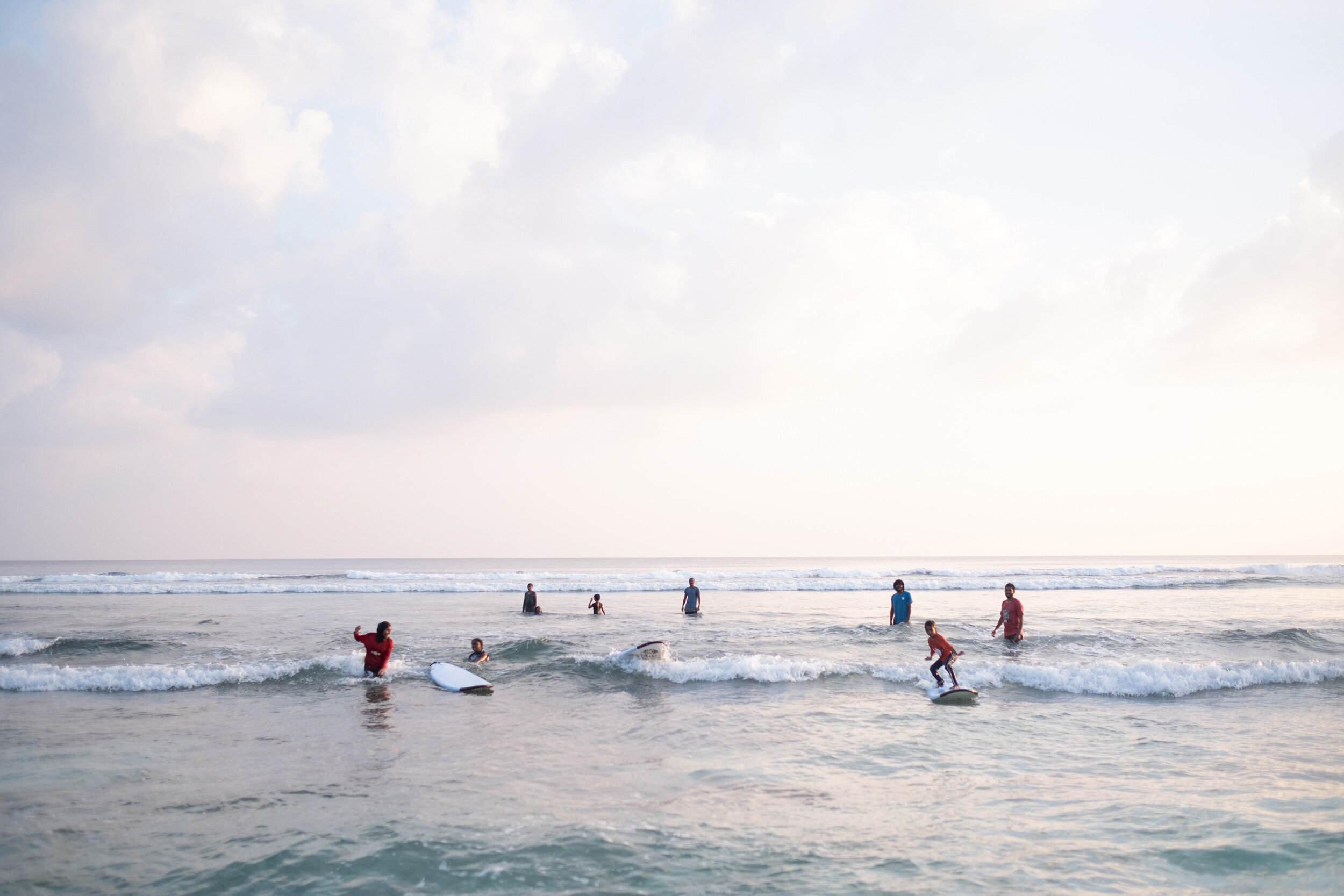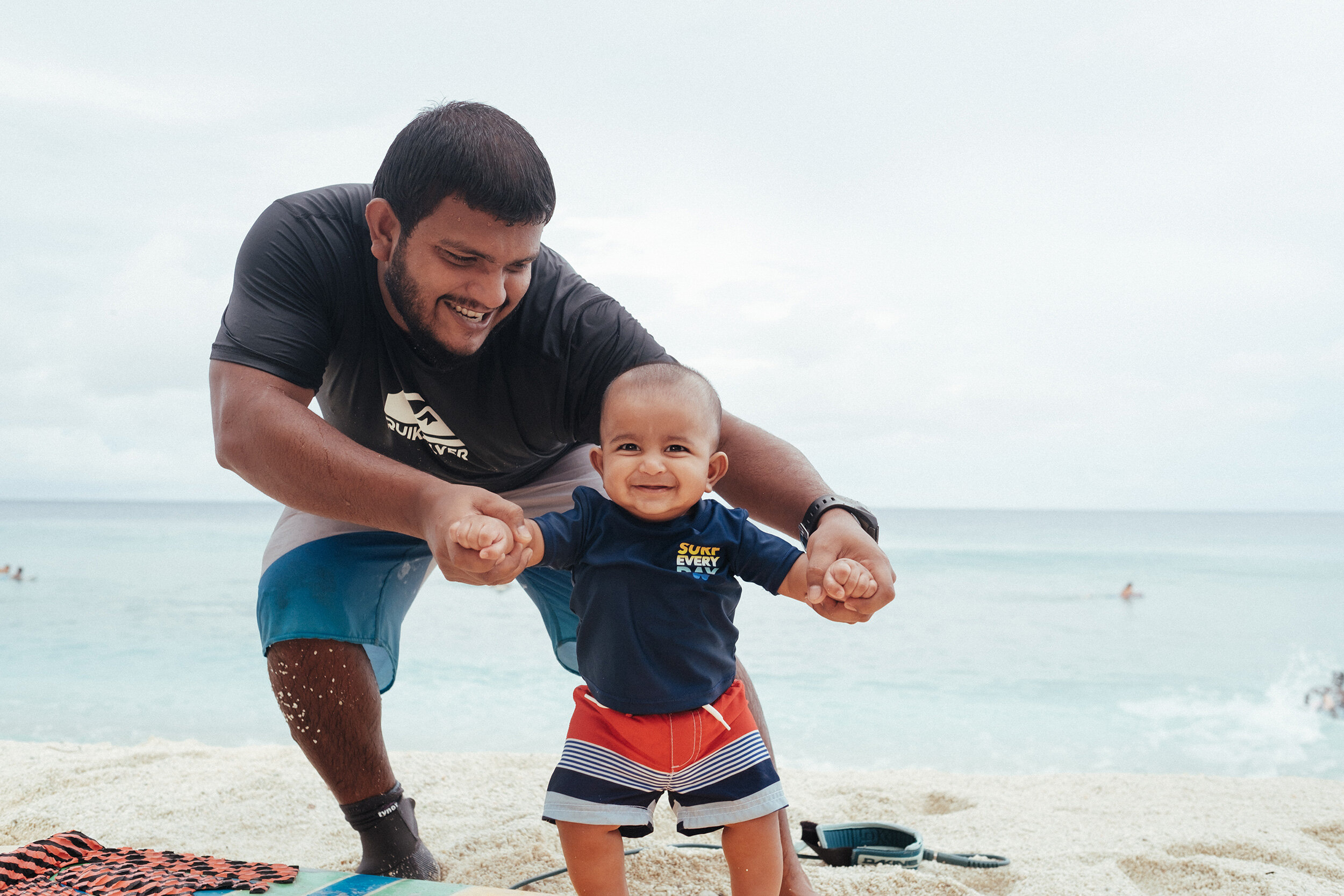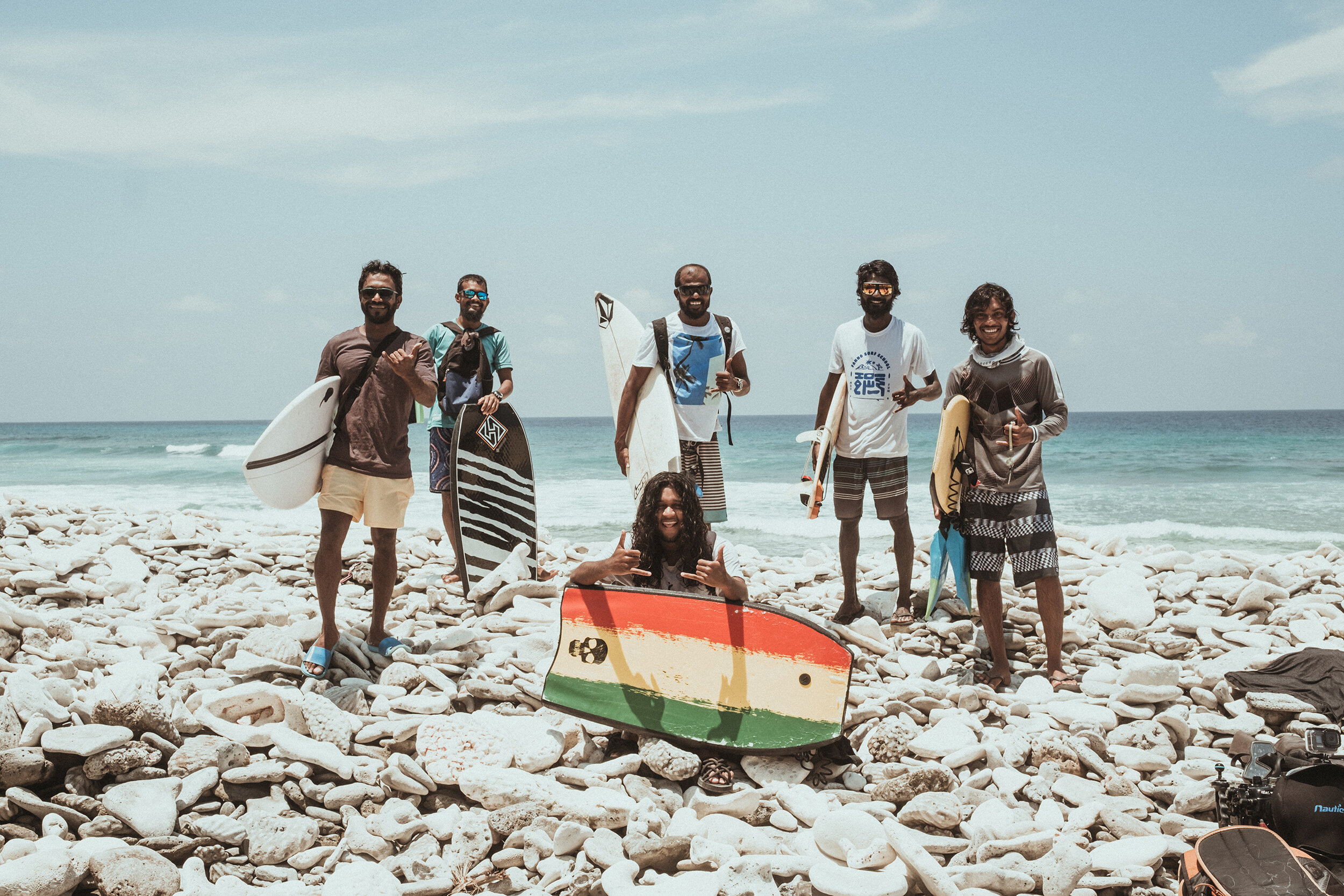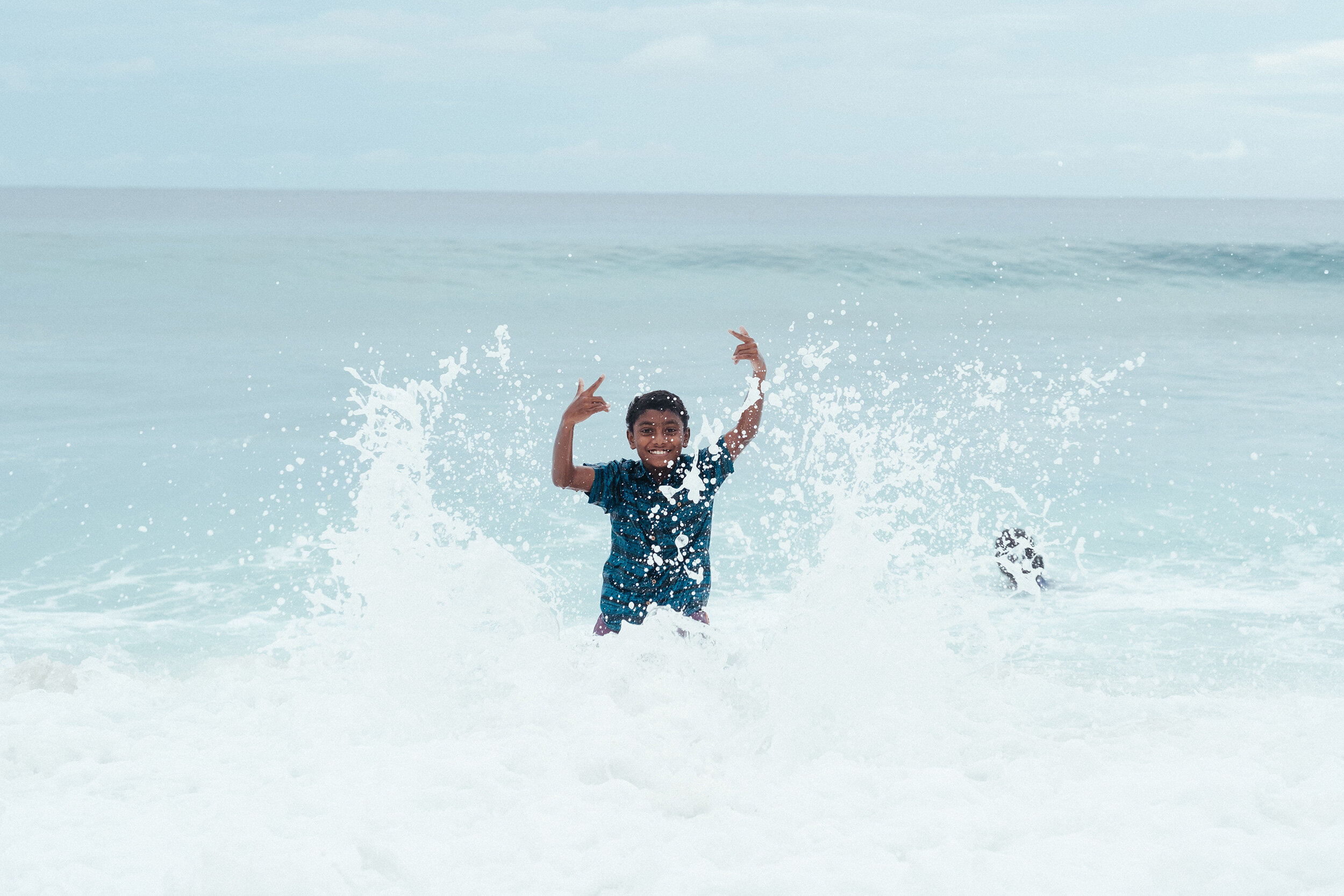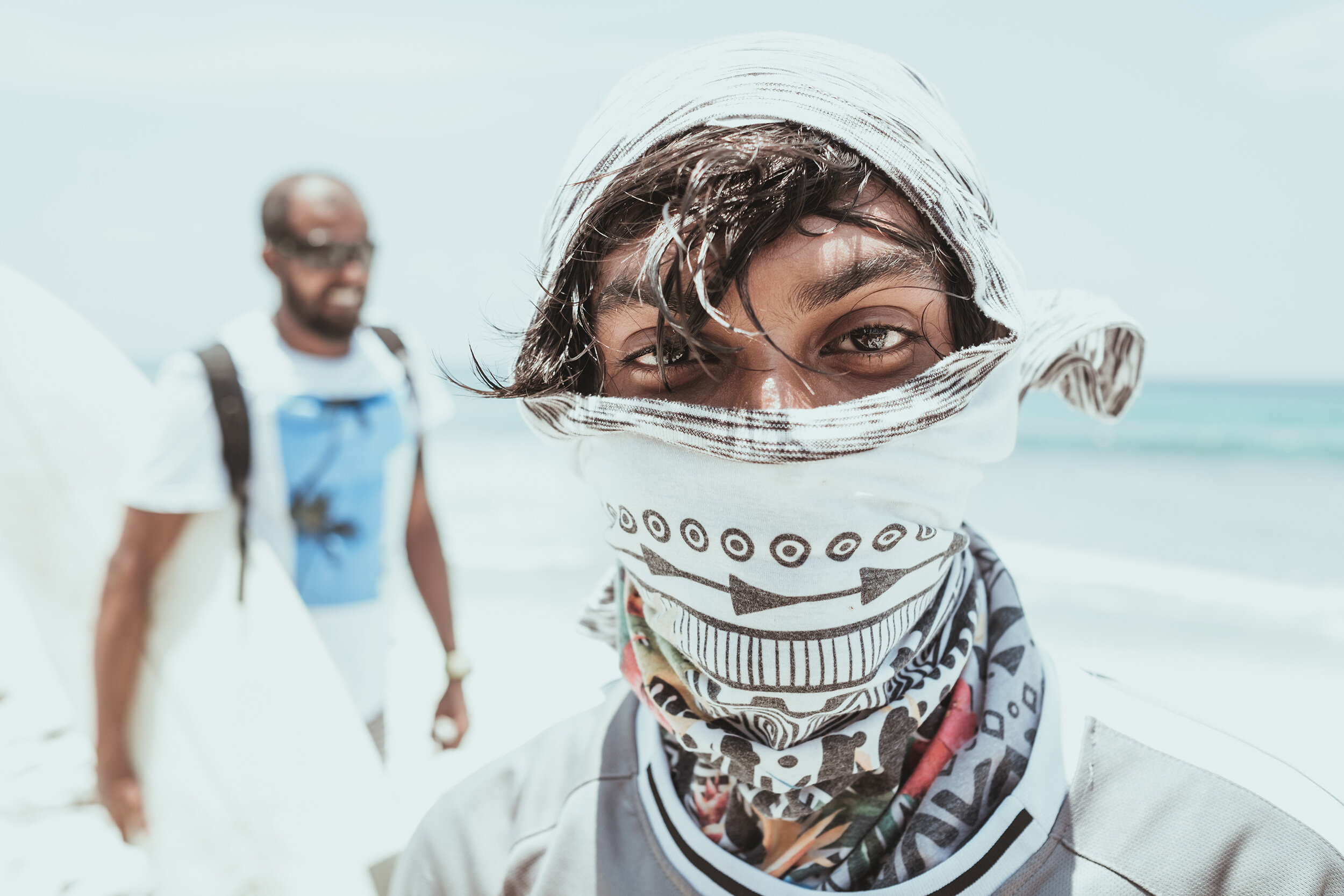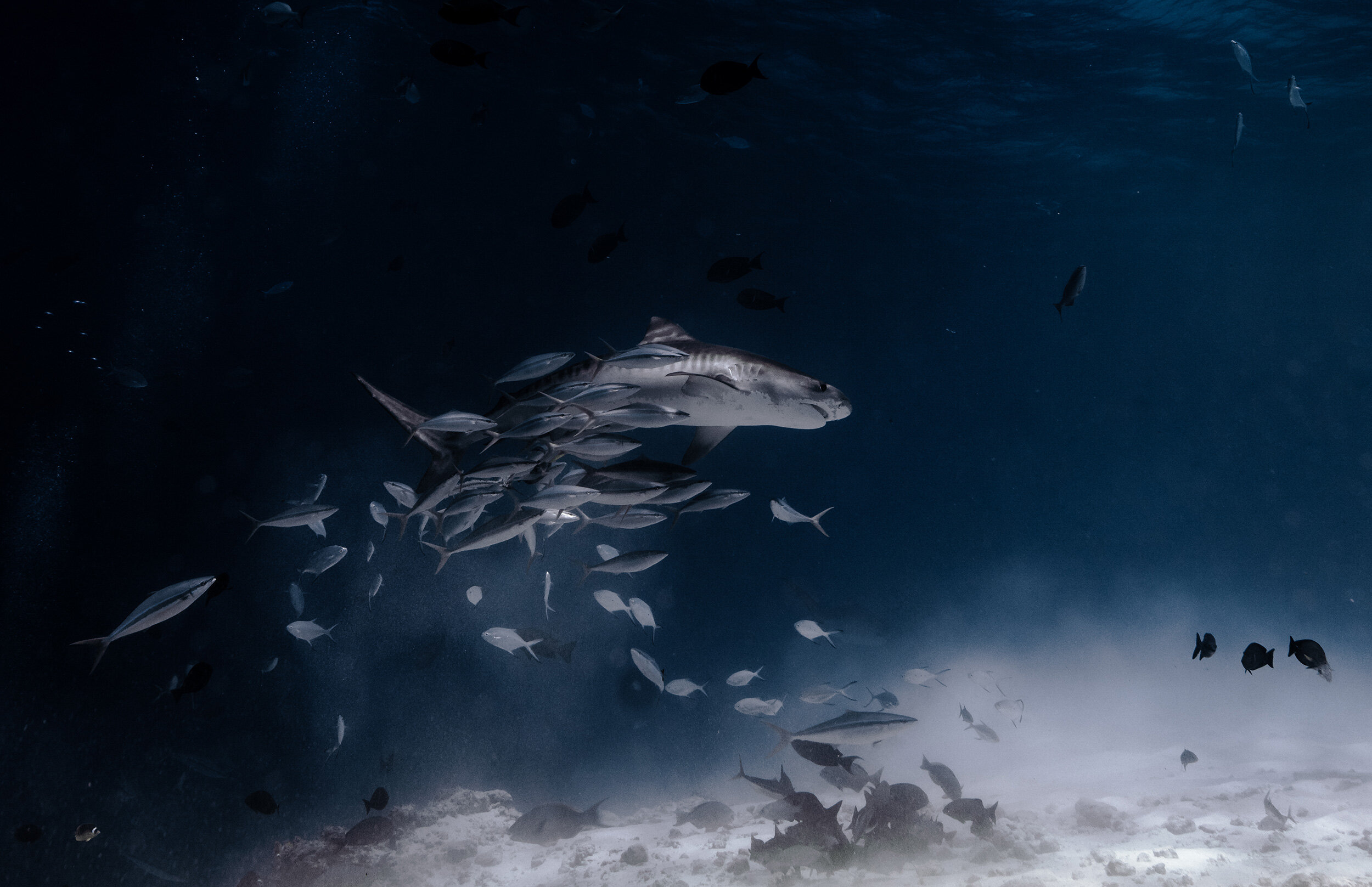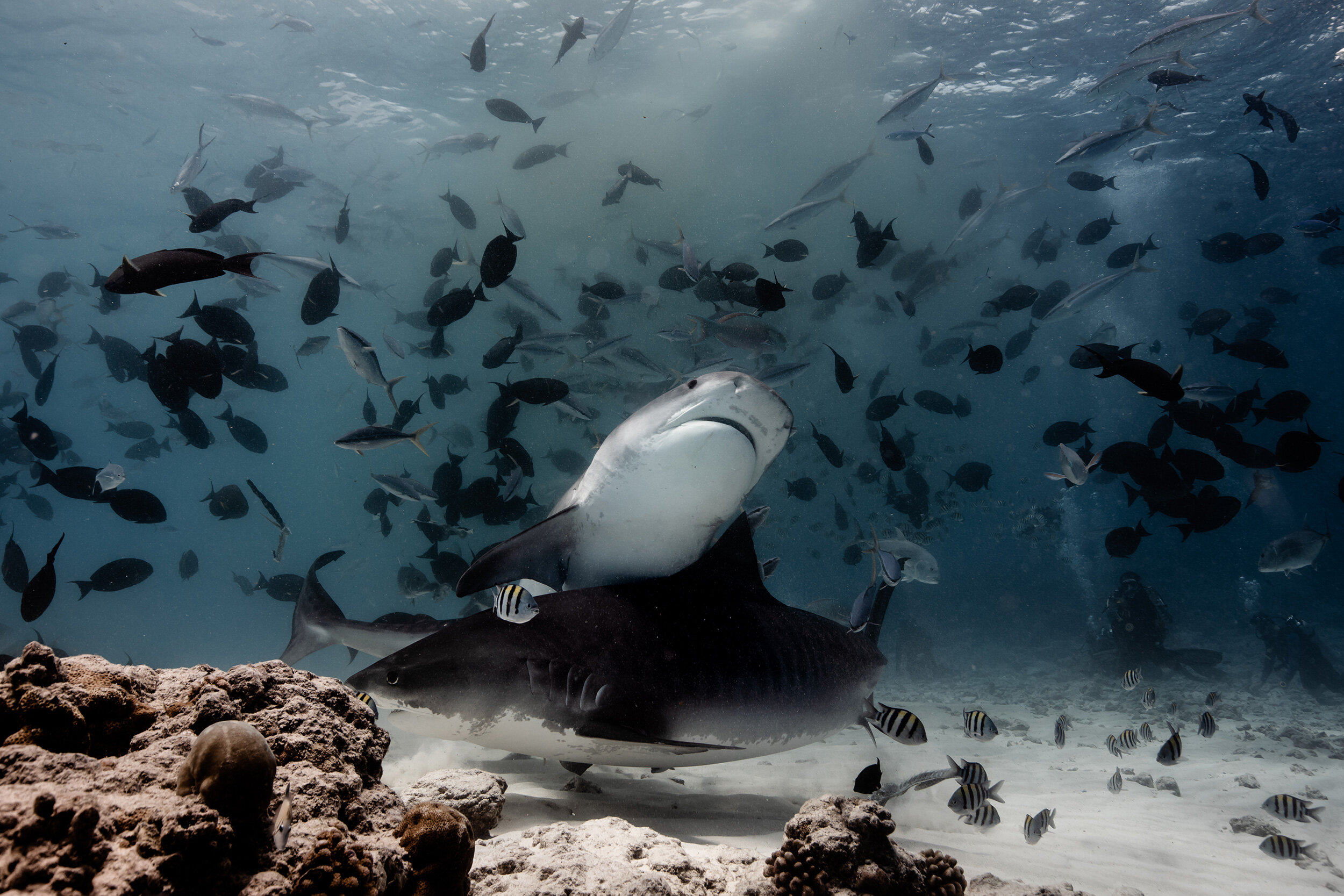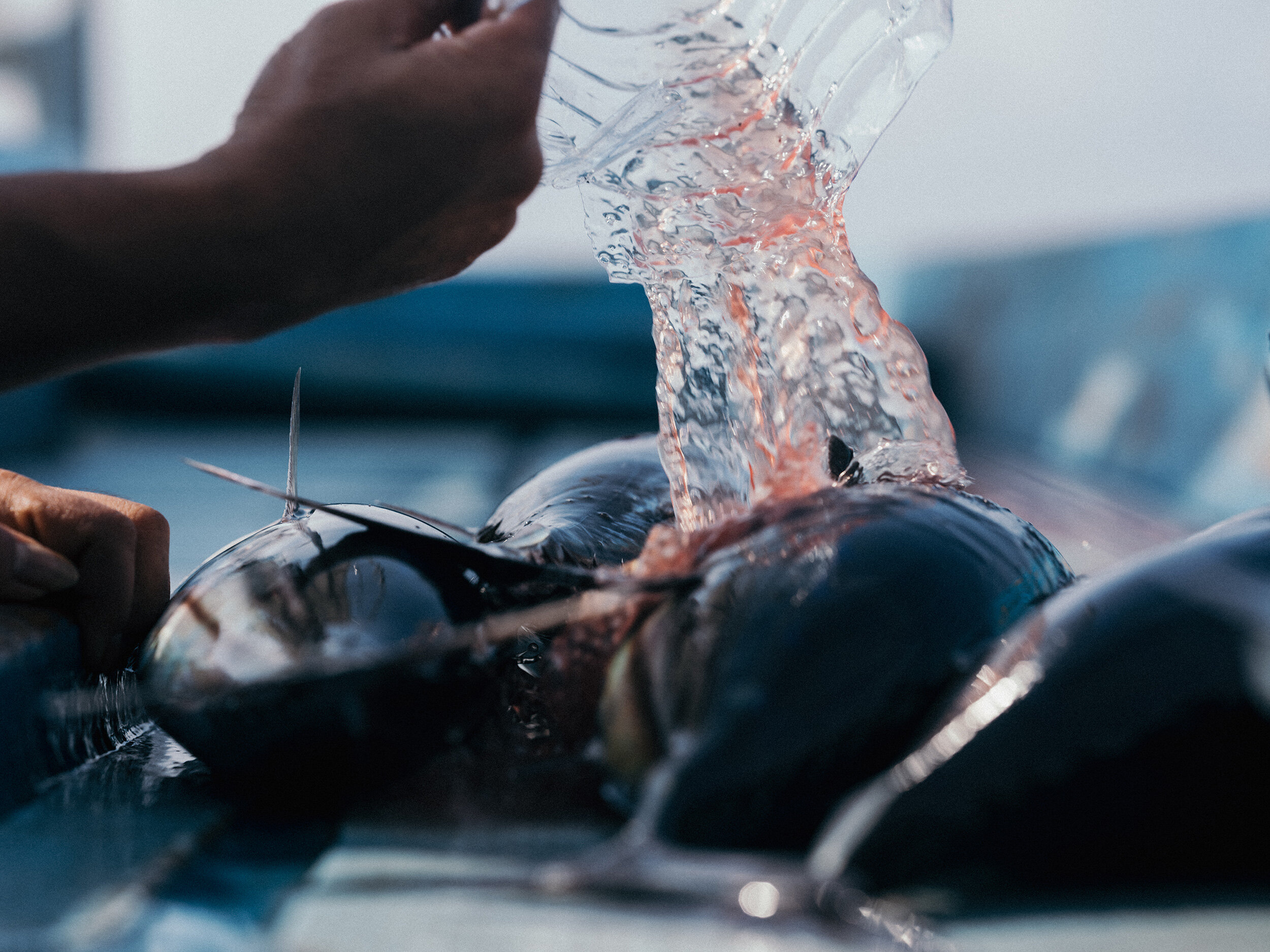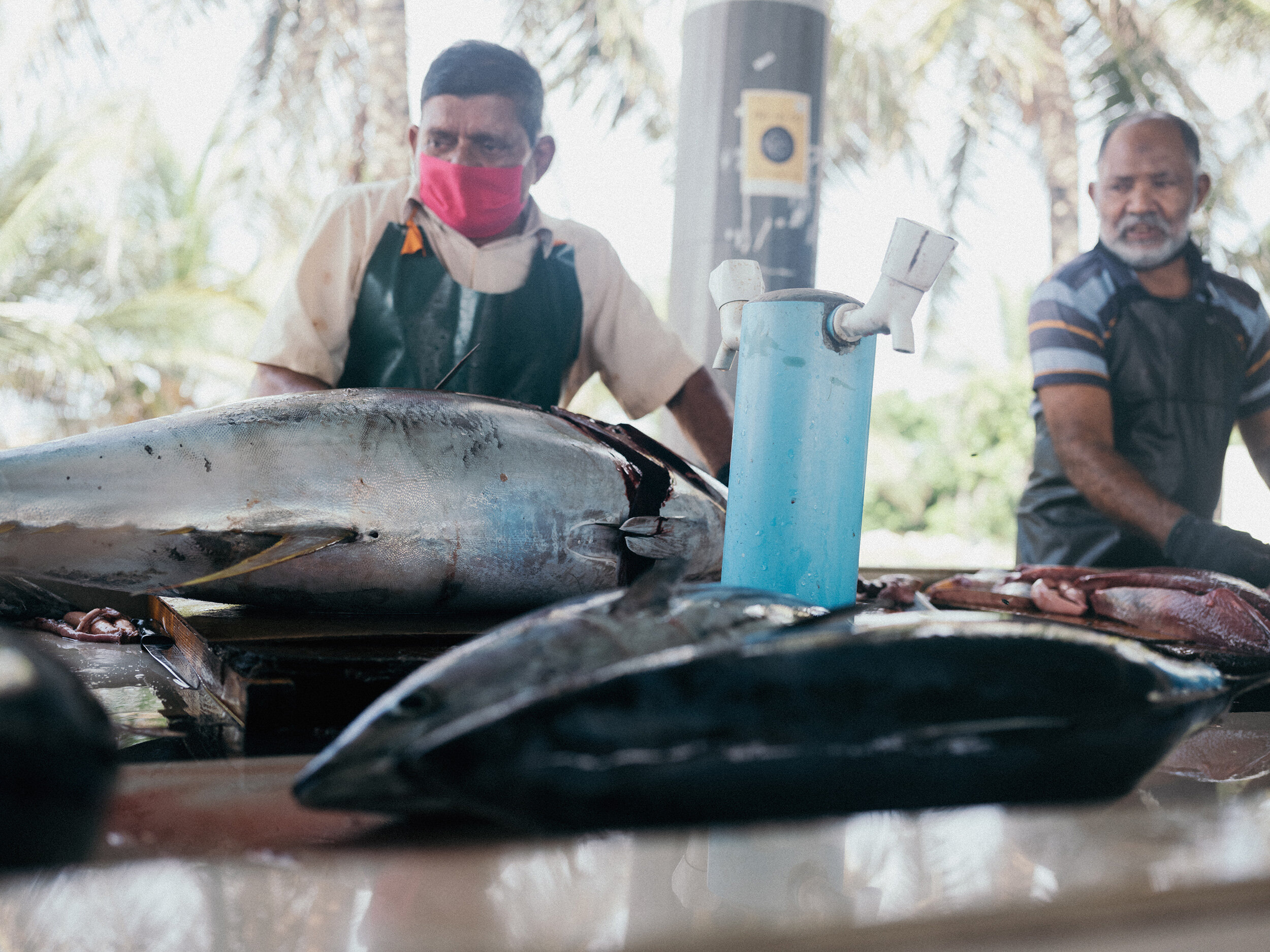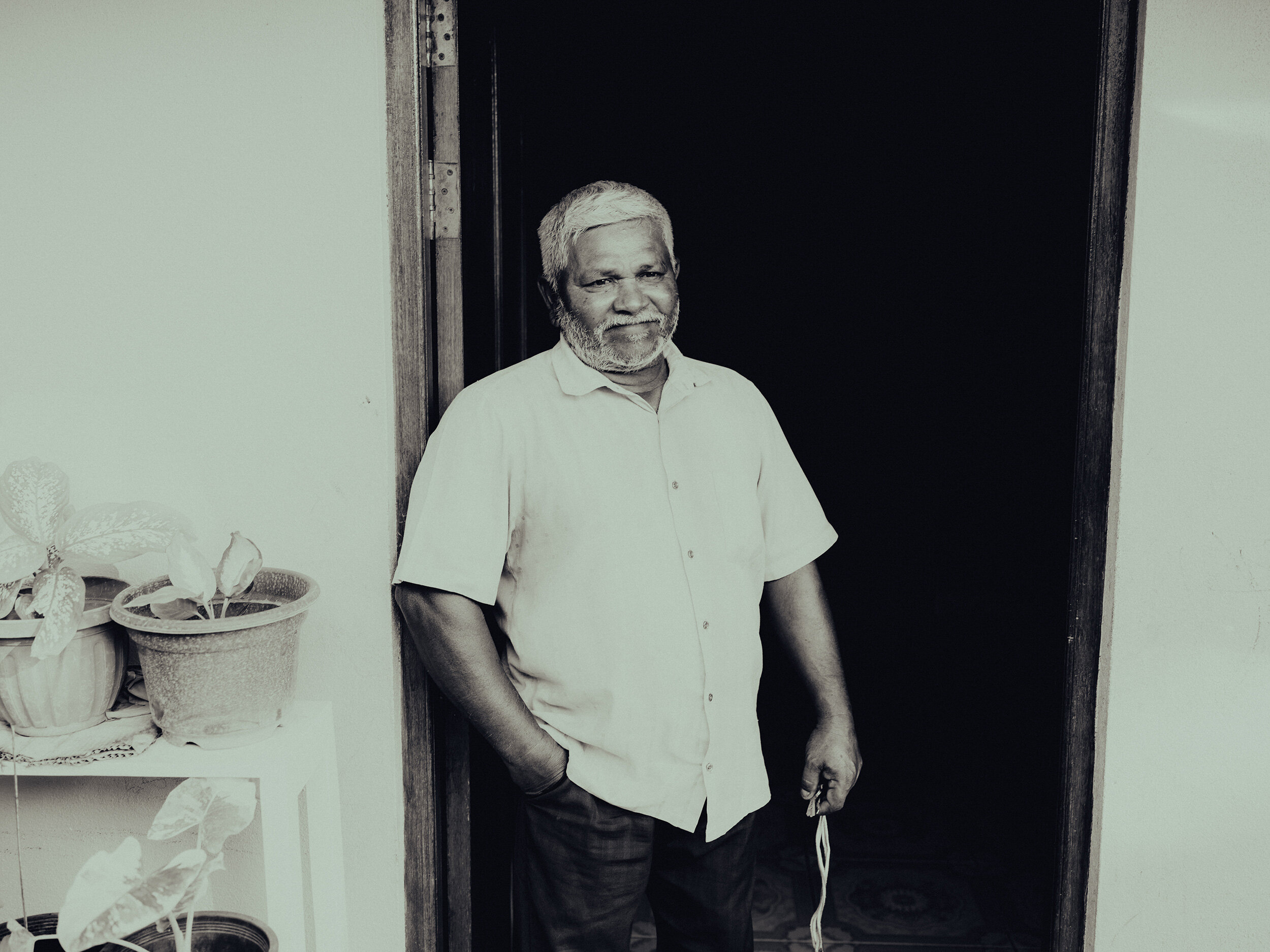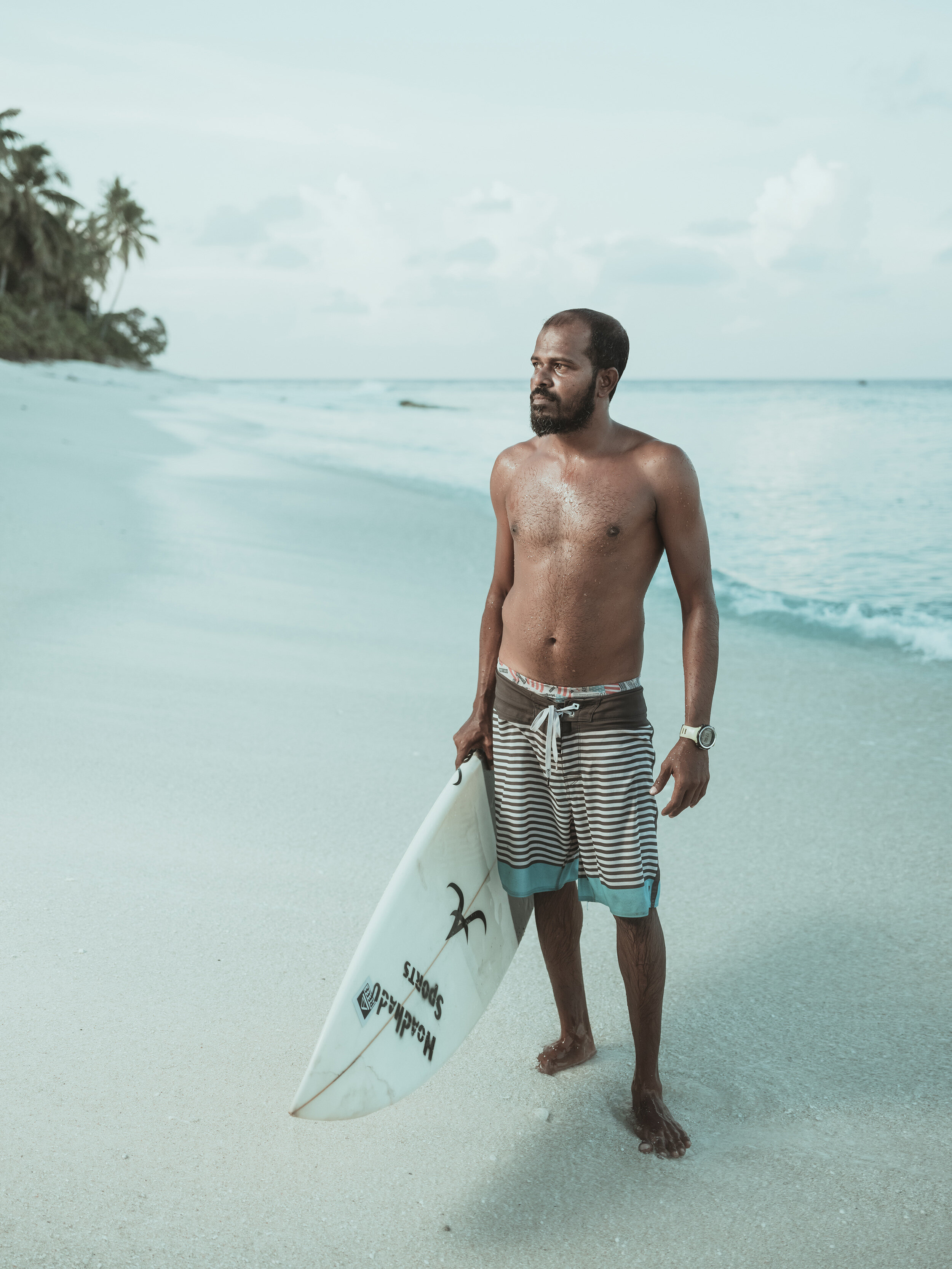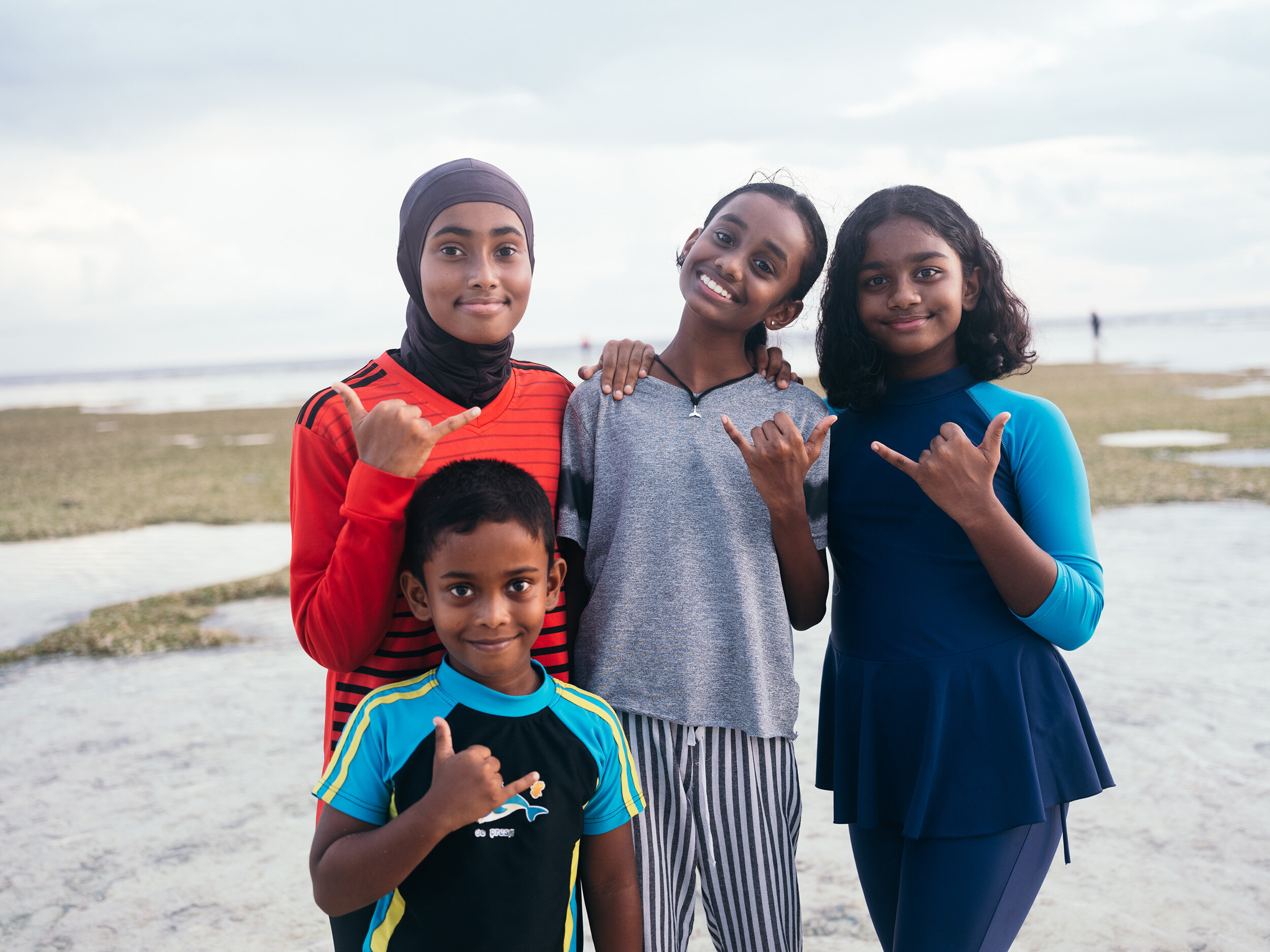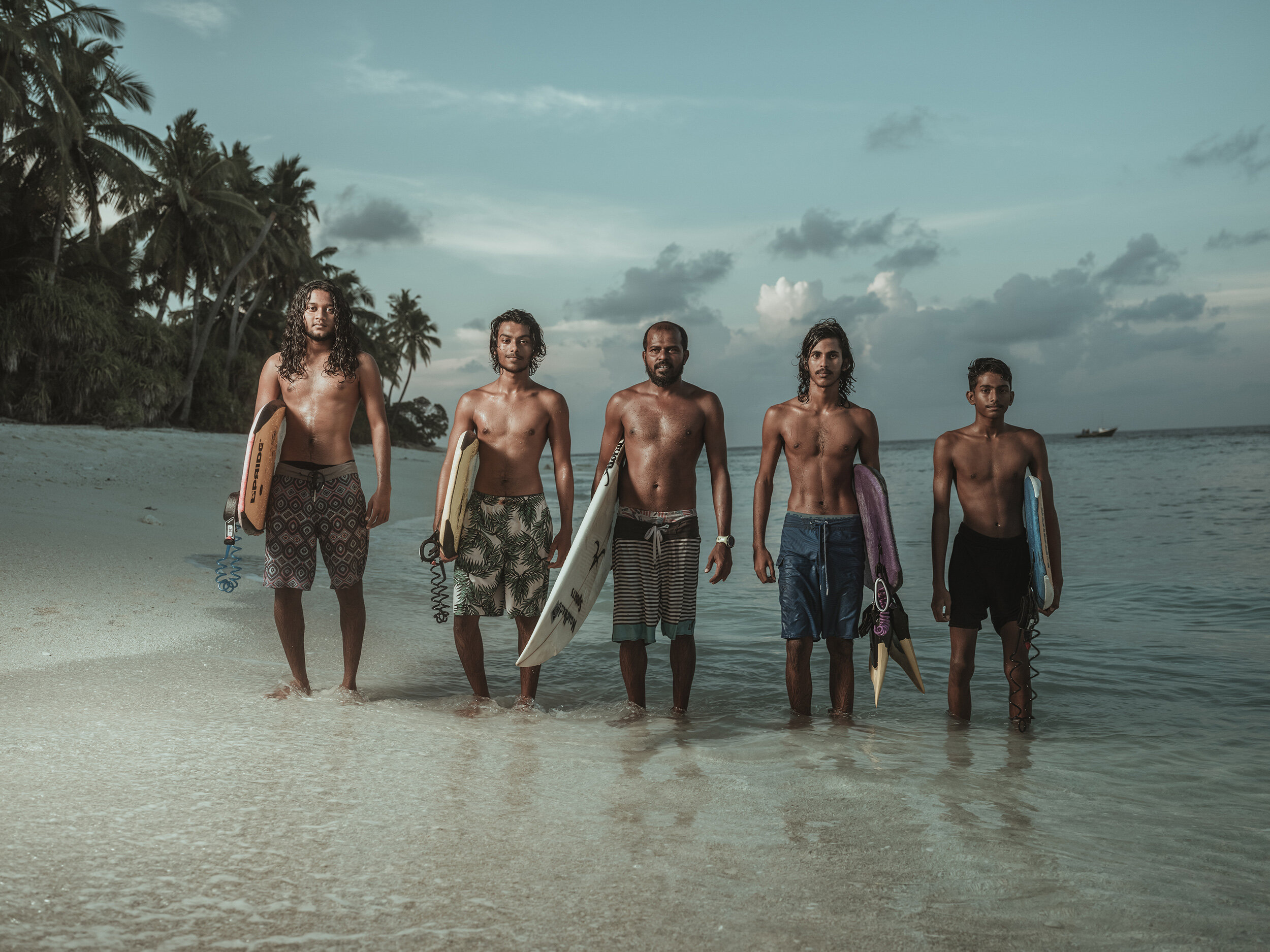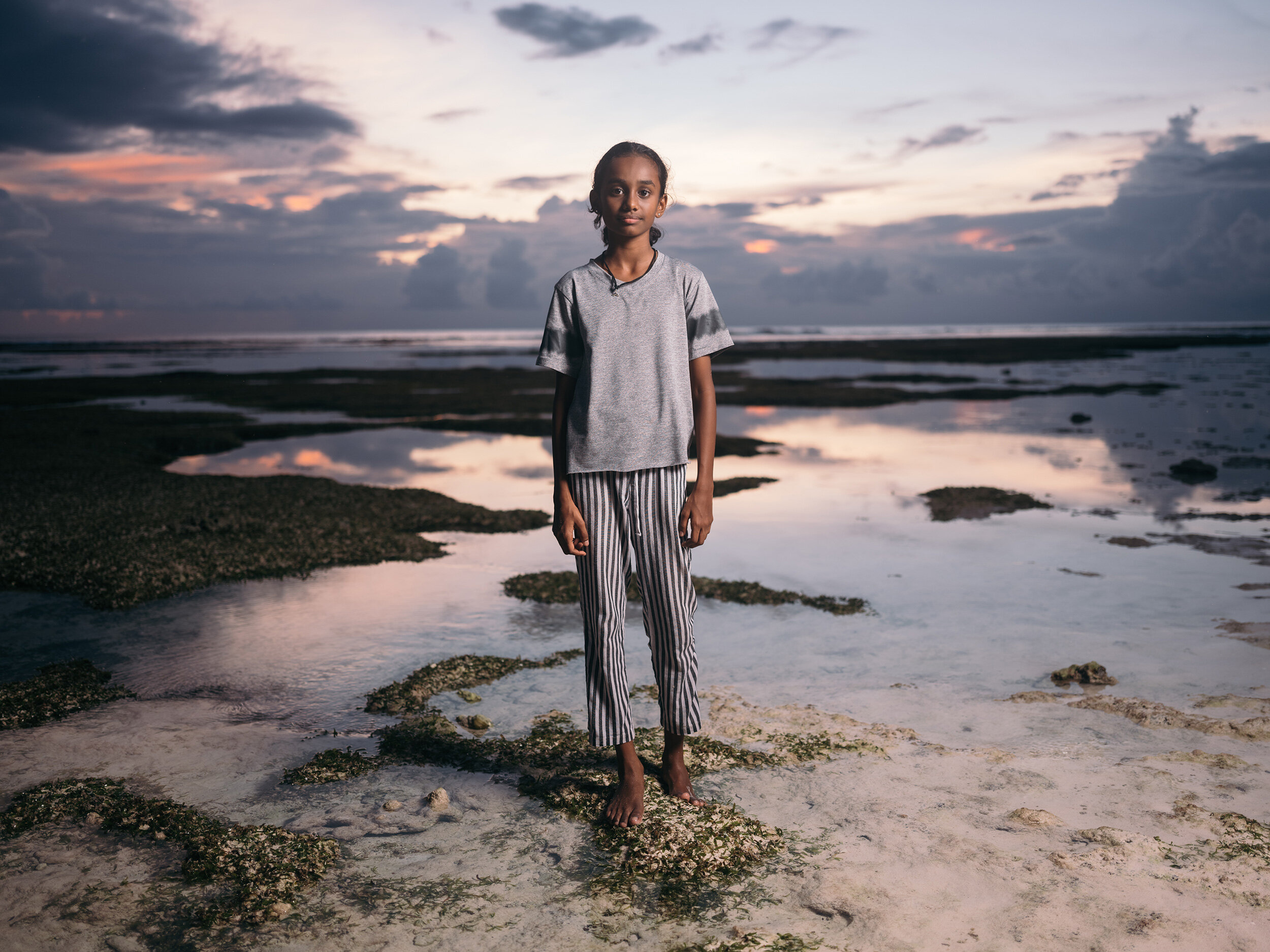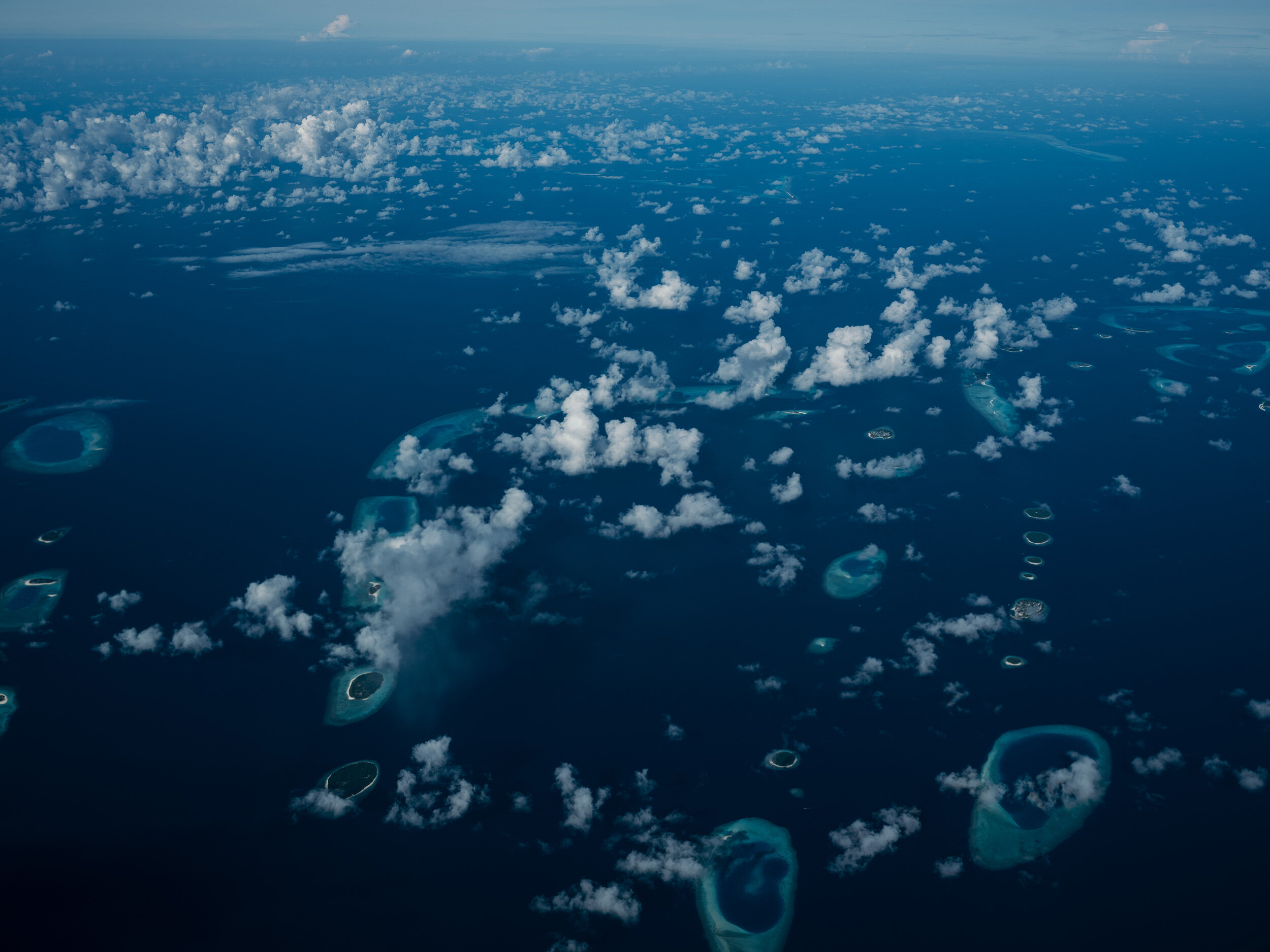To Co-Exist.
To Co-Exist.
It’s approaching 7am when we hoist our dive gear onto the dhonis. The engine starts up and we’re immediately asked to safety check our kit and get ready. We untie the ropes, ease off from the dock, and settle in for the journey of what would become an unforgettable dive and an irrefutable reminder of how we can choose to learn from nature and form a mutually beneficial relationship for generations to come.
20 seconds into our journey and only 12 meters from the dock we slow down at the mouth of the harbour and the engine cuts out. We look to the front of the boat where local dive master and guide Lonu hangs over the edge, using one hand to stabilize himself and the other to point whilst counting to eight in Dhivehi. He gestures for us to walk to him “Come, come and look, eight tigers”.
His enlightened expression and calm tone makes us unsure of his statement - there can’t possibly be a tiger shark in the harbour and only three meters away a family of swimmers and a local restaurant spot? As we find our sea legs to stand, rocking back and forth with wetsuits hanging off the bottom half of our bodies, we’re confronted by our own doubt as dark long shadows circle the dhonis.
Hoisting up his sun bleached ripped wetsuit over his shoulders Lonu points to our gear on a heap on the floor and demands we get ready to jump. Scrambling camera housings and air tanks there’s a mysterious anxious silence as we prepare to jump into the unknown, placing our ultimate trust in a man with little to say, but so much to give.
We jump at 7.15am, half a mile down the coast from where we first witnessed the broken shadows of Tiger Harbour. We descend to mere 30 feet where we meet the edge of the reef wall, surrounded and completely arrested by an abundance of colour and life. Breathing is steady, and eyes are wide as we swim back towards the harbour. The crackling of the reef and schools of tropical fish soon act as a calming distraction and our focus becomes our immediate surroundings. Lonu glides through the water, and gestures for us to all keep looking in front, almost like he knew what was going to happen next.
He positions himself five meters into the blue from the reef wall, whilst we perch on the outer edge, showing no hesitation he begins swimming further down before re-emerging beside us alongside a 8 meter female Tiger shark who we later learn is named Pirate due to her missing eye. Hands interlocked behind his back and perpendicular to her stripes, they swim alongside each other. An astonishing dynamic hard to explain, and a connection so indescribable even if we were able to speak underwater words would not do justice.
Before long we were surrounded by six adults. Remembering the guidelines Lonu had instructed; keeping direct eye contact at all times and giving these animals the space and respect they so dreadfully deserve, we began to settle into our dive and learnt things from this encounter that no book, movie or secondary account could ever teach.
Within 30 seconds of descending, this site soon became a place like no other. A gem sat on the equator in the middle of the Indian Ocean, home to pelagic life like no other and testament to a microculture of harmony and coexistence that we soon came to learn is in desperate need of protection.
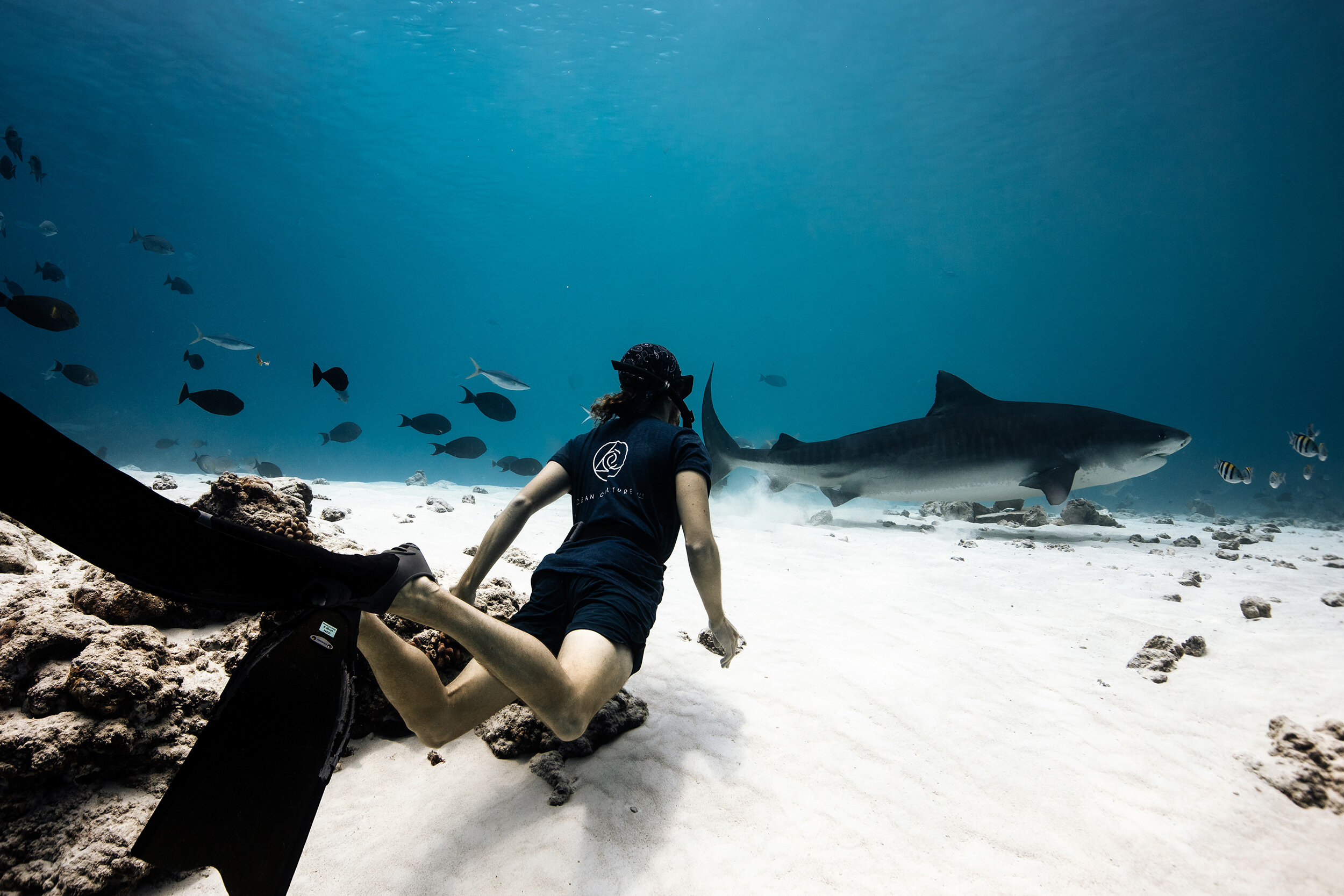
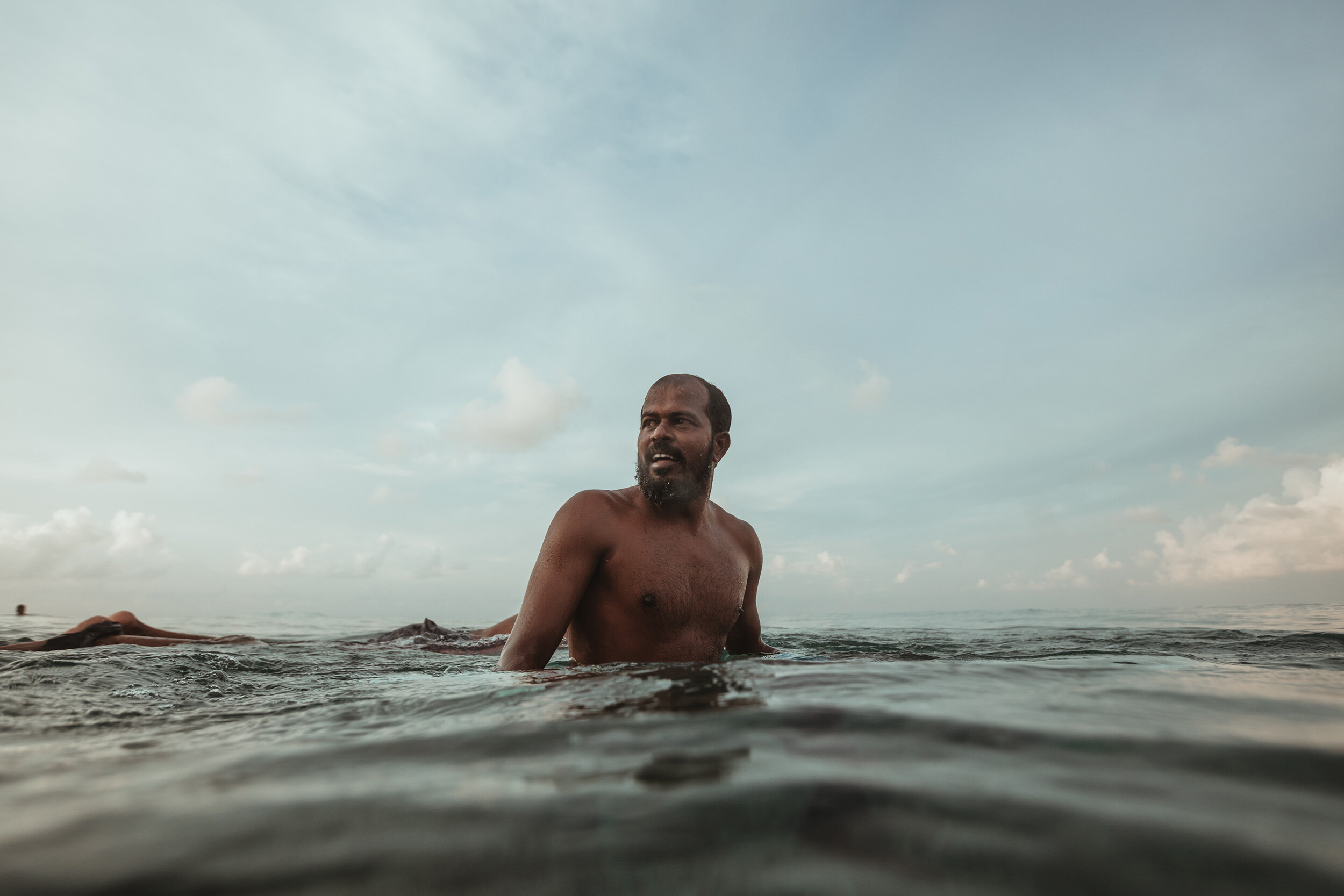
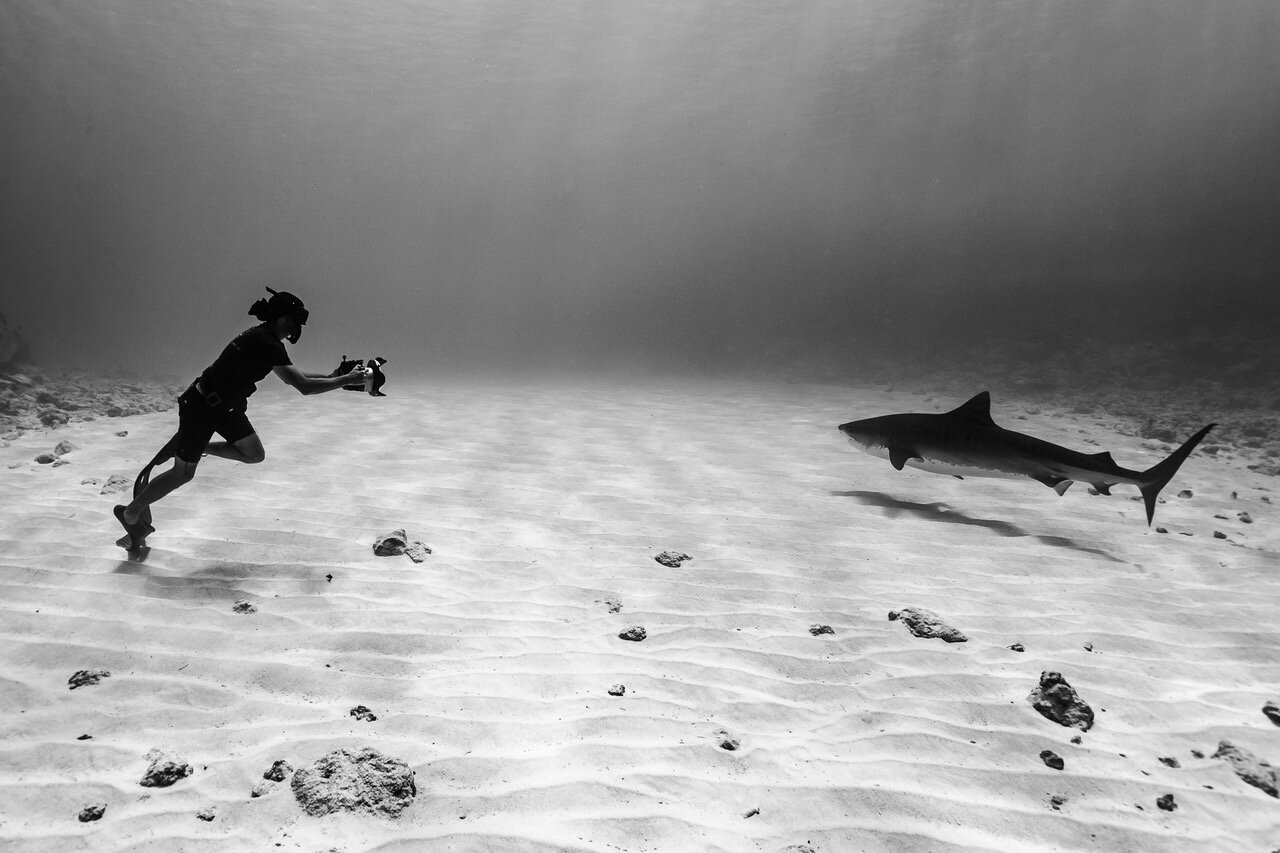
The island of Fuvahmulah, located in southern Maldives is a 1300 hectare UNESCO biosphere reserve home to 11,000 residents, boasting the most diverse coral ecosystem in the country with its healthy habitats and unique sand beach formations. The reefs are home to arguably the healthiest tiger shark population in the world, alongside thresher, hammerheads, white tips and whale sharks. The geography of this single island atoll is unique, with no other land masses nearby and ocean current patterns that make it a wonderful nursery and cleaning station for a wide variety of pelagic fish. It’s unique volcanic underwater landscapes and steep drop offs are said to be attractive for hunting purposes, paired with the island's historic fishing plant that was functional in the 1960’s. It’s widely understood that the local tiger population heavily congregates around the harbour due to the daily overhaul of fish guts as fishermen return from their trips.
Commonly known by the nation as ‘Shark Island’ due to an almost guaranteed sight of these incredible animals upon every dive, this local island community have surfed, swam, dived and fished their way into a peaceful, harmonious relationship with a species that’s widely feared and threatened.
Local ocean goers like Lonu have shared their backyard with tiger sharks for many years and have developed an undeniably fascinating relationship with these apex-predators, enough to identify them in seconds and record their individual observations and behaviour.
““I spend every day in the ocean and take photos to show to my friends and family. That way they can see what is below the surface. Learning to understand these animals has changed our lives for the better. We rely on the sharks for our jobs, we love the sharks.” ”
This micro culture of harmony and coexistence is a gleaming testament of an unwritten, unspoken understanding between humans and sharks. One that we can all learn from, for the benefit of both humankind and the future health of our oceans, and one that challenges existing policies around the world that opt to capture and kill sharks in coastal areas to reduce the number of predators on public beaches.
Whilst there are indeed many factors that contribute to the safety of diving, surfing and swimming alongside these predators in Fuvahmulah, including the all year round visibility, when asked, locals believe that if they protect the sharks, the sharks will in turn protect them.
“If we respect sharks, they will take care of us. We must protect the shark for the future of our island”
Islanders of Fuvahmulah have redefined the way they interact with these animals and in doing so, respectfully built a relationship with these apex-predators that has changed their lives for the better. But in order to co-exist, sharks need to exist, and a lack of international agreements to monitor, manage and control shark fisheries and trade, paired with the continued misunderstanding of these creatures continues to pose a daily threat to the species.
The misunderstanding of these creatures isn’t their only threat. The island's healthy shark population has subsequently earnt much attention and whilst much of the island is reliant on tourism, a recent significant influx of visitors has begun putting pressure on the dive sites and the infrastructure of the island.
To support the presence of increased tourism, roads and guest houses are being built to enable the transportation and accommodation of guests to the island. This development can be seen as positive for urban development; however, it is often done at the expense of natural habitats such as the ocean. With an overwhelmed and under resourced waste management system, plastic is a common sight along the beaches and the streets of Fuvahmulah. Around 200,000 plastic water bottles are imported to the island every month for 11,000 residents due to the lack of water filtration systems. The island's mountain of trash and plastic, almost three stories high, is growing faster than it can be exported to Thilafushi aka “trash island.” This pile up is largely due to the island lacking any kind of waste sorting system, and almost no recycling initiatives being practiced. Green waste, metal waste, recyclables and single use plastic waste are all being dumped on site together and left unsorted. As a result, plastic is both washed up on the beaches of Fuvahmulah from aboard, while also seeping into the ocean from the island itself. The impact of this has been witnessed first-hand with whale sharks being spotted entangled with plastic so tightly it cuts into their skin. A recent rescue involved a local dive guide cutting an industrial plastic sack from the body of an entangled whale shark on the shores of the island.
We've witnessed how saturation and over-capacity can result in physical stress on the infrastructure and on natural, cultural and heritage assets when economic growth takes priority over the environment. We only need to look at Boracay in the Philippines and Maya Bay in Thailand where some ecosystems have reached their breaking point and governments have had to close entire islands in order to allow habitats and species to rehabilitate. Many locals are aware of the threats over tourism can present, and have expressed concerns, frequently hosting community clean ups and would like to see changes that will allow for the sustainable development of their beautiful home.
The regulation and management of dive sites after a number of disputes with local dive operators and visiting liveaboards is also a programme locals would like to see implemented.
“Tiny dive site, forty of fifty people, around four guides, and it’s mayhem. It’s an accident waiting to happen” - Jono Allen
Whilst work has to be done on the ground in order to implement and manage a sustainable growth development policy, this can often take years to facilitate with many different stakeholders involved, and the predicted rate of growth is alarming in comparison to the island's long term plan. Finding a balance between development and sustainability is paramount in ensuring the longevity of a healthy tourism industry and marine environment.
Whilst Fuvahmulah City Council and Fuvahmulah Marine Foundation are working towards frameworks that allow cultural and environmental preservation, the need for future visitors to become part of the solution rather than part of the problem by not only acknowledging the beauty of this island but also the fragility is of great importance for the future of this magical atoll and the sharks who call it home.
The island of Fuvahmulah demonstrates what it looks like to live with sharks everyday, and allows visitors an incredibly unique, life changing opportunity to learn the power of observation and connection in order to encourage the conservation of this keystone species.
Photography: Matt Porteous , Jono Allen
Film: Tom Webster
Words: Tamsin Raine
